The Shetland Pony Experience

Most Recent: Reviews ordered by most recent publish date in descending order.
Detailed Reviews: Reviews ordered by recency and descriptiveness of user-identified themes such as wait time, length of visit, general tips, and location information.

The Shetland Pony Experience - All You Need to Know BEFORE You Go (2024)
- (9.51 mi) Rockvilla Guest House
- (9.61 mi) Fort Charlotte Guest House
- (5.93 mi) Scalloway Hotel
- (4.42 mi) Brekka Lodge Self Catering
- (5.79 mi) Hayhoull Bed & Breakfast
- (9.56 mi) No 88 Kitchen and Bar
- (8.83 mi) Fjara Cafe Bar
- (9.57 mi) The Dowry
- (9.58 mi) Peerie Shop Cafe
- (9.53 mi) Da Steakhoose
- (0.01 mi) Banna Minn Beach
- (1.30 mi) Houlls Horses & Hounds
- (5.56 mi) The Mousa Boat
- (9.58 mi) Seabirds and Seals Noss Boat Tours
- (9.58 mi) Shetland Seabird Tours - The Noss Boat

Where to meet Shetland Ponies in Scotland – the Shetland Pony Experience
Where to meet Shetland Ponies in Scotland The Shetland Pony Experience – Shetland is known for its tiny ponies. But, at best, most tourists are lucky enough if they randomly pass a few ponies in a field or on the roadside. Finding somewhere to get up close to these iconic animals was challenging, until now. [*Contains affiliate links]
The Shetland Pony Experience
The Shetland Pony Experience is run by crofters and riding school owners (mother and daughter) Barbara and Elaine Tait, with behind-the-scenes help from dad, George. The tour lasts one hour, with a maximum of 24 guests to create a personal experience with the ponies. The guests are split into three groups of eight, across three different stations. Children are completely welcome, and read on to discover why being small is an advantage.
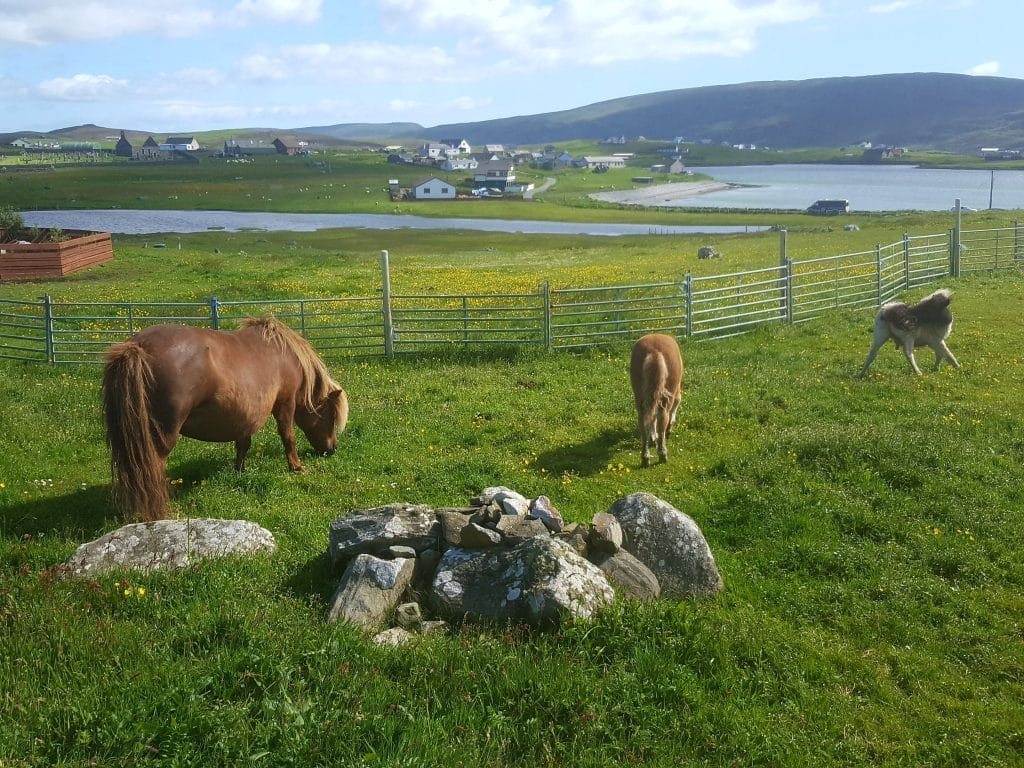
Station 1 – Paddock
After a swift introduction and health and safety briefing, guests receive their first taste of Shetland Pony life when they’re introduced to the mares and their foals in an outdoor paddock. I think Shetland Ponies are cute, but the ponies are beyond gorgeous. They nustled into me and tried to chew my coat. [Tip – Wear wellies or outdoor shoes, and leave your favourite glad rags at home.]

Elaine explained how ponies are born outdoors – they are so hardy they are outdoors all their life. Shetland Ponies generally belong to a ‘stud’, and the Taits’ ponies are all known as ‘Merkisayre’. If you’re in the know, the stud name reveals where a pony comes from.
Station 2 – Riding Arena of the Shetland Pony Experience

Next we headed inside to the Riding Arena, built by Elaine’s dad George. Here, guests are can read display boards revealing the history of the breed and what constitutes a Shetland Pony. Details include the fact that they can be any colour, except spotted, and there is a height restriction. These wee ponies can’t be bigger than 42 inches from the withers to the ground if they are to be classed as an official Shetland Pony.
Their size meant that ponies replaced children underground during the 18th century, when child labour in the coal mines was finally banned.
After learning my history, it was time to get hands on again. I was given a comb to groom the white blond Merkisayre Duster. Grooming is a summer activity because, in winter, it’s important that the oils that keep the coat waterproof aren’t dispersed. After grooming my little pony (which did remind me of playing with My Little Pony at school) it was time for action!
Riding Arena Obstacle Course
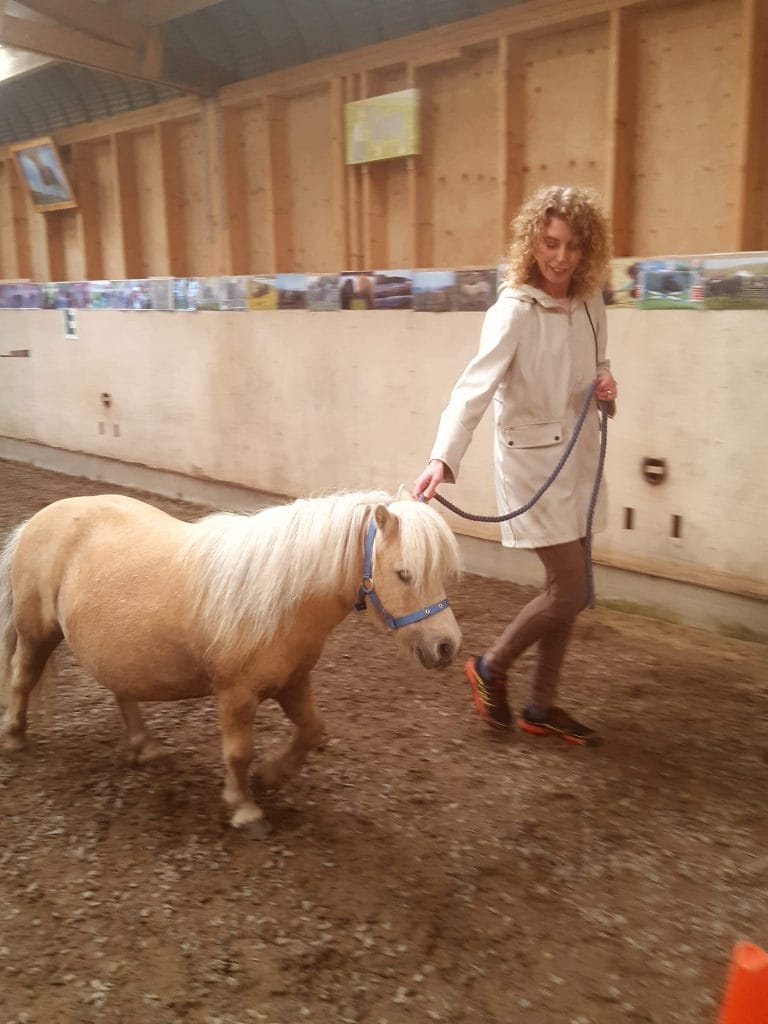
The next part of the arena experience involved an obstacle course. I was handed the reins to Merkisayre Duster to lead her round cones and over poles. It was quite straightforward, and she was pretty obedient, but I was strangely nervous and proud to complete it without incident. A Shetland Pony is heavier than it looks, so one of the main objectives was to ensure the pony didn’t stand on my foot.
Ride a Shetland Pony
I was dismayed, but not shocked, to discover I was too big to ride the ponies. But this is when being a wee one is an advantage – children under nine stone can ride the ponies.
Book a Lerwick Walking Tour here.
Station 3 – Beach Walk

The last station was my favourite, simply because it was so beautiful. We led our ponies from the croft, across the sandy grass, down to Bannamin beach. Elaine and Barbara ensure it’s one pony between two guests, so you really get quality time with the animals, on a stunning stretch of Shetland coastline.
I walked my pony next to the waves, and it did feel utterly timeless – I could have been in any century, at any time. The islands’ scenery makes for a jaw dropping backdrop. I have never been this close to a Shetland Pony in all my days, and it was wonderful.
Photo Opportunity during the Shetland Pony Experience

Elaine and Barbara take time to capture great photos of their guests on your own phone, so I posed with my very own Shetland Pony. The Taits don’t believe in restricting photographs or selling them – personally I find it annoying when I’m charged an additional £15 or more for a photograph of myself! Once you’re part of the experience the photographs the team take on your phone are your own to treasure, show your friends or share on Facebook.
Read a Complete Guide on Things to Do in Shetland

At the end of the experience I was offered a memento to take home with me. After a tough decision between a rosette or a notepad, I opted for the pad and pen to jot down all my Shetland memories.
Location of the Shetland Pony Experience
It sounds remote but the Shetland Pony Experience is only a 25 minute drive from Shetland’s capital of Lerwick. From Shetland’s mainland, drivers cross Trondra onto the island of Burra. The three islands are linked by causeways, roads and bridges so it’s no problem whatsoever. [One tip – my Satnav drove me to the middle of nowhere, and phone reception was limited, so get clear driving instructions before you head off.]
Ticket Prices and Seasonality
The Experience is a flat rate per person (no concessions) and it is a seasonal experience so click here for the current prices and info. For an in depth list of things to do in Shetland, read a detailed guide here – there’s so much going and lots of family friendly activites and attractions.
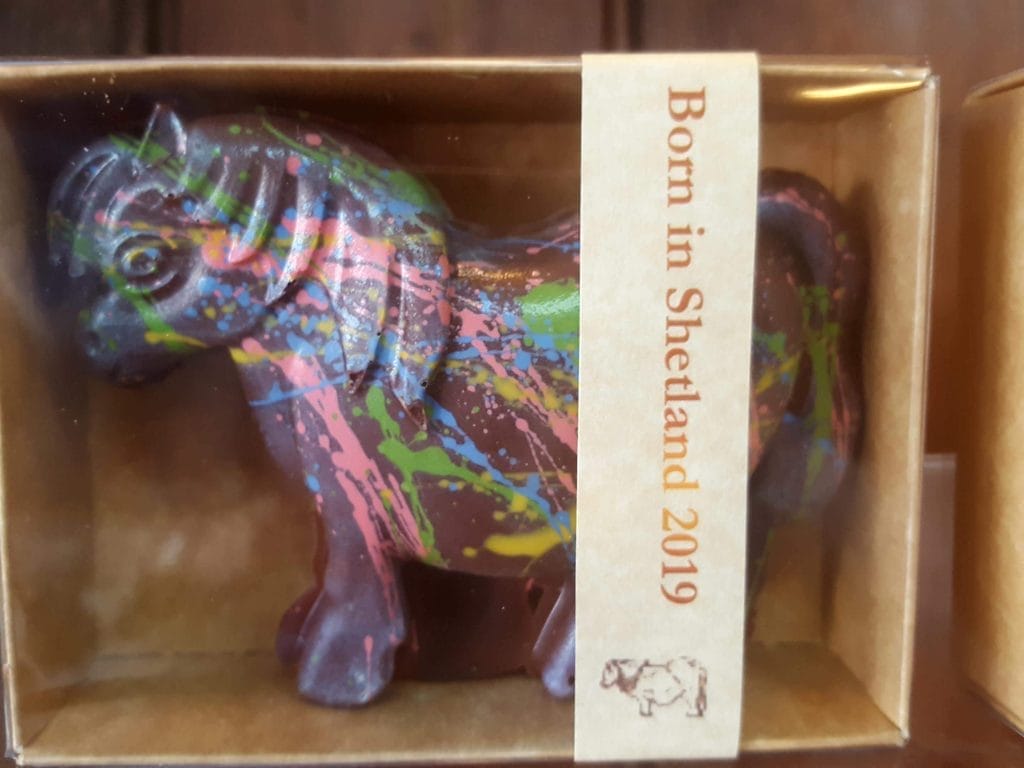
And if you fancy some Shetland pony souvenirs, I don’t think you can beat these cute chocolate ponies in the Lerwick chocolate shop Mirrie Dancers chocolatiers.
The Lowdown
Read a review of Getting to Shetland aboard the Ferry
I caught the overnight Northlink ferry from Aberdeen to Lerwick (read more detail about the experience here, it’s an adventure in itself). I picked up a hire car from Bolts at the terminal. I’d definitely recommend them because renting a hire car in Shetland is so easy it almost verges on relaxing, and it’s a very reasonable price, with great personal service. From the terminal I headed into town for a quick look around the shops and a coffee, before driving out to Burra. Driving is so easy in Shetland, every for less confident drivers.

The Shetland Pony Experience will be a dream come true for many youngsters. Even as an adult there was something so rewarding about spending time with these tough, tiny creatures. If anything, I have to wonder why it’s taken so long for someone to invite tourists to meet their wonderful ponies.
If you enjoyed Where to meet Shetland Ponies in Scotland – the Shetland Pony Experience then don’t miss a post, sign up here . Join the conversation on Facebook, or check out the bonny photos on Instagram . For any queries or opportunities please email [email protected] . Text and images copyright of Scots2Travel. Check out our Privacy Policy here . I was on a work trip to Shetland, and under no obligation to share this on the blog.
Similar Posts
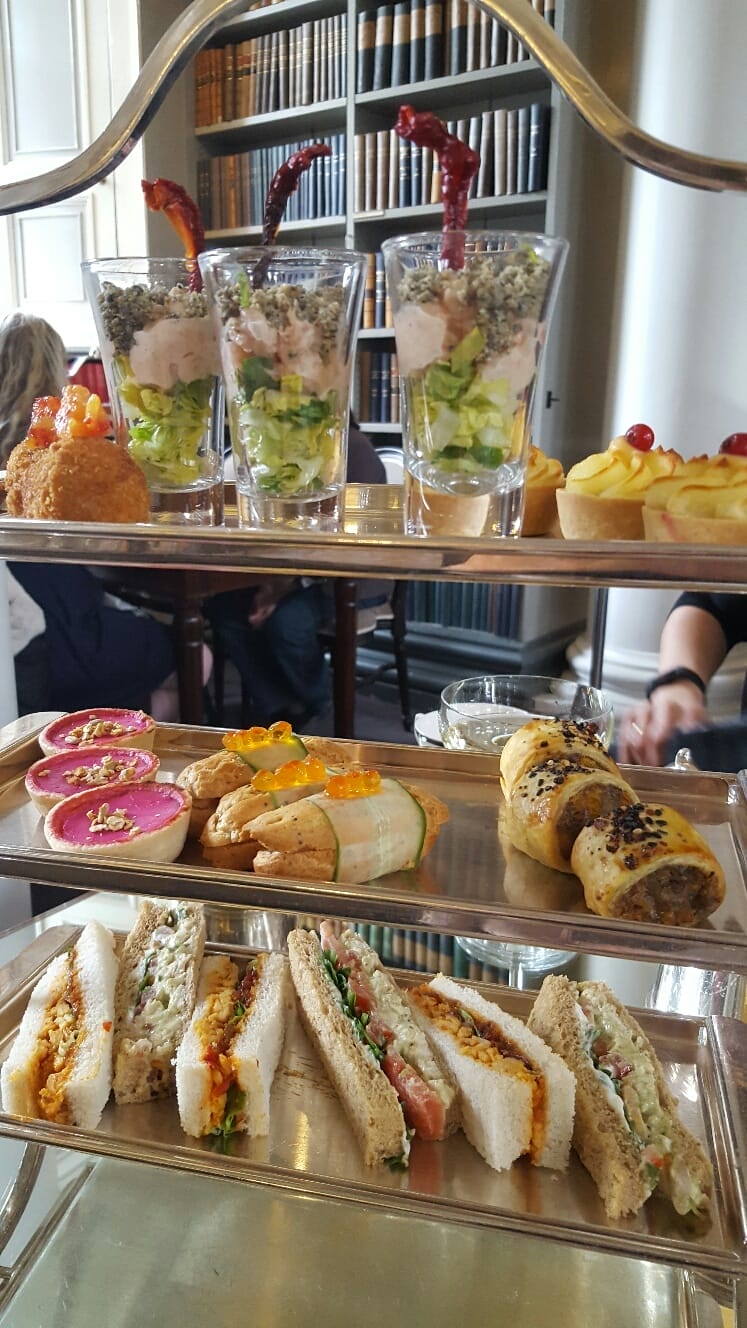
Scotland’s Best Afternoon Tea at Colonnades, Signet Library, Edinburgh
I’m not a raver, in terms of overly enthusing about things, or in terms of big fish/little fish dance moves, but occasionally you feel the need the rave about something as good as this.
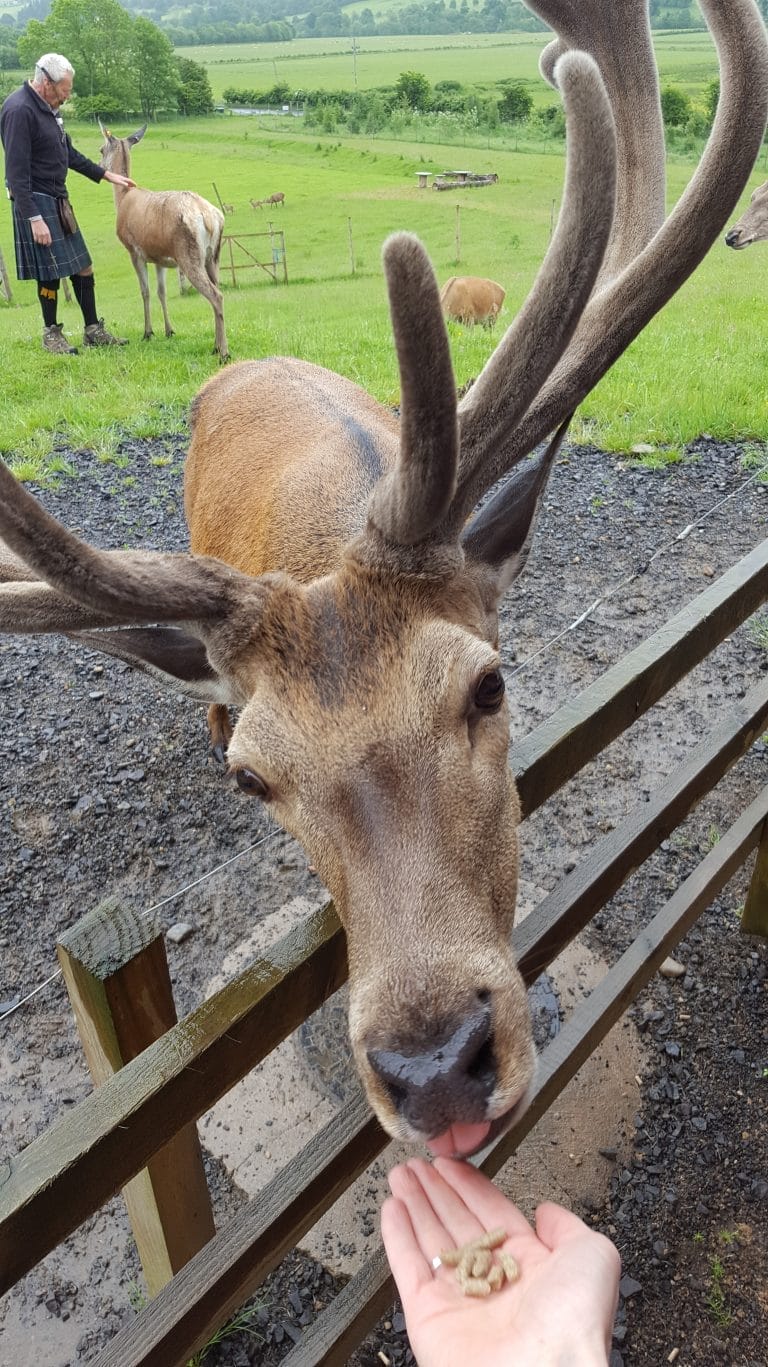
Highland Safari Red Deer Centre & Barn Owl Experience, Perthshire
Highland Safari Red Deer Centre- When we were staying at the Moness Resort in Aberfeldy one of the memorable day trips was spent hand-feeding red deer…
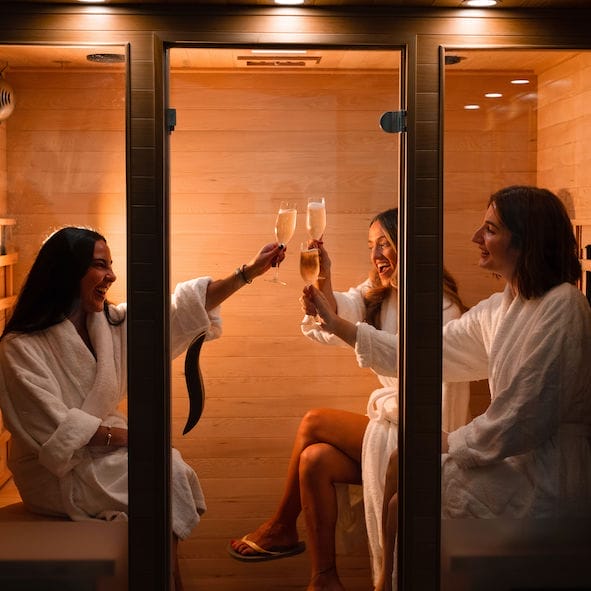
Spa Weekend Scotland
Spa Weekend Scotland – I’m most excited about the quality spa hotels offering truly excellent deals, but this list of great spa breaks includes luxury,…

Oslo on a Budget – Vigeland Sculptures Frogner Park
Take time to admire the beauty of this park from afar. Introducing Vigeland Park in Frogner Park, Oslo – it’s a unique spot, so bring some beauty and art in your morning.

Puerto Alcudia Majorca with Kids
Puerto Alcudia Majorca with Kids – From beaches and the Old Town, to train journeys and day trips to Palma, discover family fun in Spain.

Things to do in Dunfermline with Kids
Scotland’s newest city really impressed with the amount of historic sites, stories and food crammed into its remarkable Heritage Quarter – it’s SO walkable. Even better, most of the key attractions are totally FREE and open pretty much all year round.
Leave a Reply Cancel reply
This site uses Akismet to reduce spam. Learn how your comment data is processed .

The Shetland Pony Experience
“GET UP CLOSE AND PERSONAL WITH THE WORLD FAMOUS SHETLAND PONIES IN SHETLAND”
A positively authentic shetland experience - open by appointment only.

Merkisayre Shetland Pony Stud

Shetland Pony Riding School

Beach Hacks

lucyliveshere
A travel and lifestyle blog
The Shetland pony experience: a detailed guide

If you love animals then the Shetland pony experience is for you! I’ve been to Shetland a couple of times but my trips have usually mostly been spent seeing family and friends – my partner is from Shetland originally and his parents live up there. However, when we booked a trip up this year for a wedding I was determined to squeeze in some touristy stuff – and number one on the list was the Shetland pony experience .
I’d seen Shetland ponies when I’d been up to the islands before, but always through a fence – where I’d have to try and entice them to come close by. This was different though. It seemed like a cool way to actually learn about the ponies and their history in Shetland and be able to actually interact with them… without the wire fencing in the way.

Plus, apart from anything else, I’d been super busy at work and I wanted to do something that was good for the soul. That’s certainly what this experience is. You’re able to get close to the ponies, learn how to groom them, and spend time with them. What’s not to like?
I couldn’t think of a better way to spend a couple of hours, especially as the weather decided to play ball and stay dry for us. The whole experience is seriously charming and, luckily, not just for kids.
Here’s a detailed review of my experience at the Shetland pony experience… I’m sure by the end you’ll be keen to book your own slot!
What is the Shetland pony experience?
Here’s the short answer: it’s the best thing ever. Now for the slightly longer answer: it’s this amazing experience on the Shetland islands where you get to get up close and personal with the Shetland ponies there. You learn about the ponies and their history in Shetland, groom them, and lead them around an obstacle course.
Plus, of course, there is plenty of time for capturing some photos. If you’re an animal lover then you really can’t go wrong. It’s a no-brainer, it’s just ace. Here’s a step-by-step guide to what you can expect…

What happens at the Shetland pony experience?
There are three main parts to the experience. Meeting the foals, grooming and the obstacle course, and then heading down to the beach.
Before the experience started, we signed a short disclaimer and then there was a quick safety briefing by the hosts. This explained that while the ponies are pretty docile and are used to being around people they’re still animals and can be unpredictable if they want to be!
Meeting the foals
Then we stepped into one of the nearby fields where we got to meet the baby foals. The two hosts, told us about the history of the experience and about the history of Shetland ponies on the islands.
This was where I had loads of questions. How do you measure the height of Shetland ponies, how long do they live for, and how much does a Shetland pony cost, and so on.
Some ponies are actually more affordable than I thought – around £400. However, if the pony had won multiple awards they’d be significantly more expensive.

Heading into the paddock
Next, we headed inside to the paddock. There were lots of interesting things to see here, including lots of rosettes on the wall.
There was also a replica coal cart on a raised platform here, which links to their history here. Shetland ponies replaced the women and children who used to work in the mines in Shetland and this was a replica of the carts they used to pull. I was quite surprised at the size of it – these ponies are obviously very strong!
There were also interesting facts about Shetland ponies on the walls. It turns out that a Shetland pony can be any shade or pattern, apart from spotted. Interesting!

Meeting Double Diamond and Duster
It’s at this part that we got to meet the lovely Shetland ponies, Double Diamond and Duster. Double Diamond – or ‘Double’ as he was affectionately termed – is the dark brown pony.
He’s the elder statesman of the ponies at the Shetland pony experience, ringing in an impressive 26 years. He’s also known for his memorable sticky-out tongue.
His teeth had become loose which then became infected, so some of them then had to be removed. The result is that his tongue pokes out when he’s going about his day!
The other Shetland, Duster, was slightly younger at age 15 and was a pale-coloured pony. We didn’t get to spend as much time with Duster but he/she was very cute!

Grooming and doing the obstacle course
First, we learned how to groom the ponies. You have to brush them with the hair, rather than against it. You also have to do it quite firmly otherwise they might think it’s just a fly pestering them! It was very relaxing doing this, it felt quite therapeutic – for me and for Double, hopefully.
After that, we learned how to lead the ponies around the obstacle course. They were very obedient and, as the owner of a wilful Labrador that seems to drag us everywhere and anywhere on a walk, Double was very docile in comparison.
We instructed him to walk on, navigate his way around the cones, and stop on demand. He was great!

Heading down to the beach
Now for the best part, leading the ponies down to the beach. As is typical in Shetland, the Shetland pony experience is only a few steps away from a beautiful scenery. You’ll lead your pony out of the paddock, through a gate and through a field that leads down to the beach.
The beach will form the backdrop for your photos with the Shetland ponies and, wow, it’s a beautiful one. Shetland really does have some beautiful beaches, they’re everywhere! Double was an amazing model and seemed happy to pose away – although he also liked to drink the seawater and munch on the seaweed scattered around the beach.
You can take photos yourself, which we did, but I have to say that our lovely hosts were great at taking photos as well. You can tell they’ve done this hundreds of times before because they knew exactly where the best backdrop and angles were. I was really pleased with how the photos came out, they’re such a great memory of such a good day.

Afterwards, we headed back up to the paddock and all the other Shetland ponies – there were around eight or so of them – were let out into the field to graze and enjoy the rest of their afternoon. That was really cool to be really close to. A few of them came over for a sniff to see if we had any snacks to give them – unfortunately not!
You can also stay on for a cup of tea or coffee with the owners. We had to get back unfortunately, but definitely stay if you have time. I did ask about a couple of the beautiful black and white photographs they have on the walls in the building. Apparently, Country Living magazine once came up and did a shoot with them there – how cool is that?!
Here’s the magazine article if you’d like to read it.

FAQs about the Shetland pony experience
Who is the shetland pony experience suitable for.
Everyone! I always have this question. Sometimes I worry that these sorts of activities – like going to the zoo – are off-limits unless you’re a family with children. Will you look like a bit of a weirdo if you want to come hang out with the animals as a grownup? Nah! Luckily all the reviews of the Shetland pony experience put paid to that. There were photos with families and children, yes, but there were also lots of adults with the ponies who looked just as delighted as anyone else to be there. What can you say, animals are just good for the soul, aren’t they? So short answer, you don’t need kids to love this experience.
Put it like this: one of the lovely ladies told us that someone once proposed to his girlfriend when they were with the ponies on the beach. So it’s definitely not just for kids.
When is the Shetland pony experience open?
It’s open by appointment only so you basically have to get in touch with them on Facebook to see if they have any slots on any days that will work for you. We originally hoped for the Friday or the Monday but neither of those days worked, so we ended up going on a Sunday.
The best advice I would give is to get in touch as far in advance as you can and to rearrange your other plans around the experience if you’re really keen to do it. This is probably even more necessary if you’re planning a visit in the busier summer months.

How much is the Shetland pony experience?
It costs £35 per person for the experience, which was worth every penny in my eyes! One thing to note – there isn’t a card reader at the location. You either have to pay in cash or transfer the money 24 hours in advance. Something to keep in mind!
Where is the Shetland Pony experience?
The Shetland pony experience is located in Bridge End in Burra. It’s only a 20-minute car journey from Lerwick so it’s fairly centrally located.
I had the benefit of travelling with a local who knew the area well and who also happens to have grown up in the neighbouring island of Trondra, so for us it was straightforward. However, it doesn’t need to be complicated for you. When you book you will be sent clear instructions by the hosts via Facebook Messenger, which I found really helpful and easy to follow. We checked off the instructions as we were driving.
The hosts ask you to arrive ten minutes before the session starts.
How many people will be in your group?
This depends. On our trip, there were supposed to be six people but two of them were delayed due to circumstances out of their control, and, unfortunately, they didn’t show up at all.
That meant there was only four of us in total, which meant each pair had their own pony to look after – which was amazing! I felt very lucky for that.
However, there are groups that book in from the visiting cruise ships and that hoicks the numbers up a lot more. Thankfully there is a cap on the number of people who are allowed to book in for a session and that is 24 people per session.

When is the best time to do the Shetland pony experience?
The experience runs between May and September each year, and then closes for the winter to give the ponies a break. I imagine the weather conditions in winter might be a bit extreme for tourists too, plus there’s the lack of daylight to consider.
We visited at the tail end of September and that seemed like a good time to visit. The weather was pretty decent by Shetland standards – we got a good window of nice weather anyway – and it was a small group. As I said earlier, if you visit in the peak season there will be crowds from the cruise ships booking up slots as well, so it can get pretty busy.
The cruise ships run April to October each year, as an FYI.
Shetland pony experience reviews
The reviews for the experience speak for themselves. Everyone is completely charmed by the ponies – and the obvious passion of owners – who make the experience so great! Here’s a flavour of some of the latest five-star reviews of the experience…
“When I learned we were going to the Shetland Islands the only thing I wanted to do was see the ponies… and this experience fit the bill! Very hands on, and our guides Elaine, Susan and Barbara were fun and knowledgeable! Benji, (my pony) will live in my heart forever.”
“When I knew I’d be on Shetland, I looked for an experience that ensured I’d meet some ponies. This experience provided that and more. Benji was our boy and he was a beautiful and sweet horse.”
“ A very well-organised and friendly time spent with gorgeous ponies. Excellent value for money and located in outstanding scenery.”

Anything else?
Are there toilets at the shetland pony experience.
I always have the most important questions whenever I go on any tourist excursion. But the good news is that the answer is yes, there is a toilet there, so all good on that front!
What else did I learn about Shetland ponies?
Another interesting fact I learned is that Shetland ponies’ coats are completely waterproof. They also live outside during all weather conditions – they don’t sleep in stables or anything.
My partner had a Shetland pony for a while when he was growing up and I remember him telling me that they kept their pony outside all the time. I remember being surprised thinking about this pony standing outside in the cold and the rain. However, this is what you’re supposed to do. And if you bring them in it’s not good for them because they’re built to withstand those tough conditions. It actually makes them less hardy. So now I know!
Where else can I see Shetland ponies in Shetland?
You can see Shetland ponies all over the island. If you travel around you’ll spot them hanging out in fields all over the island.
However, if you want to get up close to the ponies and not have to take photos of them through wire fences – as I’d done in Tingwall a couple of days earlier – then the Shetland pony experience is what you need.

What should you bring/wear to the Shetland pony experience?
1. a waterproof jacket.
According to the hosts, the experience has never been cancelled as a result of the weather. Make sure you’re prepared for whatever weather Sheland brings with a wind-proof and waterproof jacket.
2. Suitable shoes
Definitely wear suitable footwear. You’ll be walking through a field down to the beach so hiking boots or trainers you don’t mind getting a little bit muddy are essential!
3. A beanie hat
The winds up in Shetland are something else. Keep it cosy with a big chunky beanie hat so that can focus your attention on the ponies, not noticing how cold you are!
4. Hand sanitiser
You’ll have an opportunity to wash your hands after the experience but you might want to bring your own hand sanitiser with you if you’re in a rush or you prefer to use your own one.
5. A well-charged phone
Yes, of course, it’s nice to live in the moment, but I’ll absolutely treasure the photos we took of our time with the ponies. If you want photos, charge your phone up beforehand so it’s got plenty of juice.

That was my guide to the Shetland pony experience. Would you book a visit on a trip to Shetland?
Share this:, leave a reply cancel reply, discover more from lucyliveshere.
Subscribe now to keep reading and get access to the full archive.
Type your email…
Continue reading
We've refreshed our website design so things may look a little different if you've been here before. We'll be making more improvements soon so watch this space.
15 Top Things To Do In Shetland
From incredible nature to contempory arts, Shetland is a real adventure and a truly cosmopolitan place - not on the edge but in the centre of the northern seas. Step back in time to the dawn of civilisation at ancient ruins, admire beautiful handcrafted Viking-style longships and enjoy some of the most spectacular wildlife sights in Europe. From Shetland beaches to Shetland pubs, there are attractions for everyone.
Walk Across The Shell Sand Tombolo South Mainland
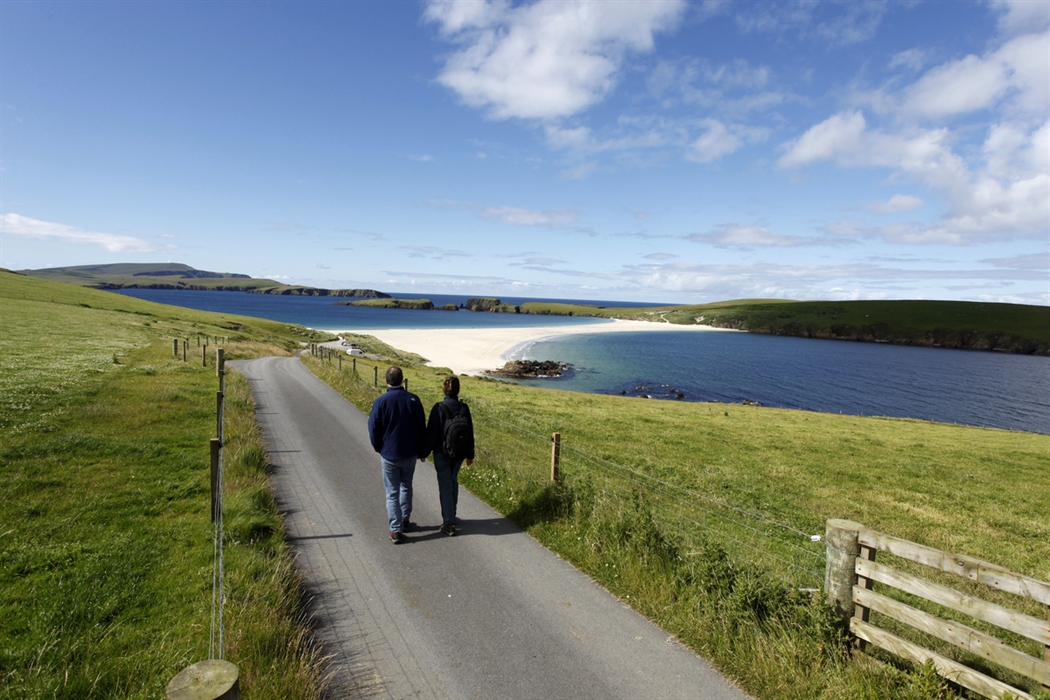
St Ninian's Isle, joined to Mainland by a tombolo of sand at Bigton, Shetland.
© VisitScotland / Paul Tomkins, all rights reserved.
Shetland’s coastline has every sort of beach – boulder-strewn beaches as well as many stretches of white or golden sand beaches and everything in between. With just under 1,700 miles (2,700 km) of breathtaking coastline, it's impossible to list them all, so here is just a selection, each of which has something special to offer.
The most well-known is St Ninian’s. Technically not a beach, it connects St Ninian’s Isle to the Shetland mainland, is 500 metres long and the finest of its type in Britain. Framed by the cliff scenery of north Yell, the sandy beach at Breckon is one of the island’s highlights.
Keep Your Eyes Peeled For Wildlife Shetland
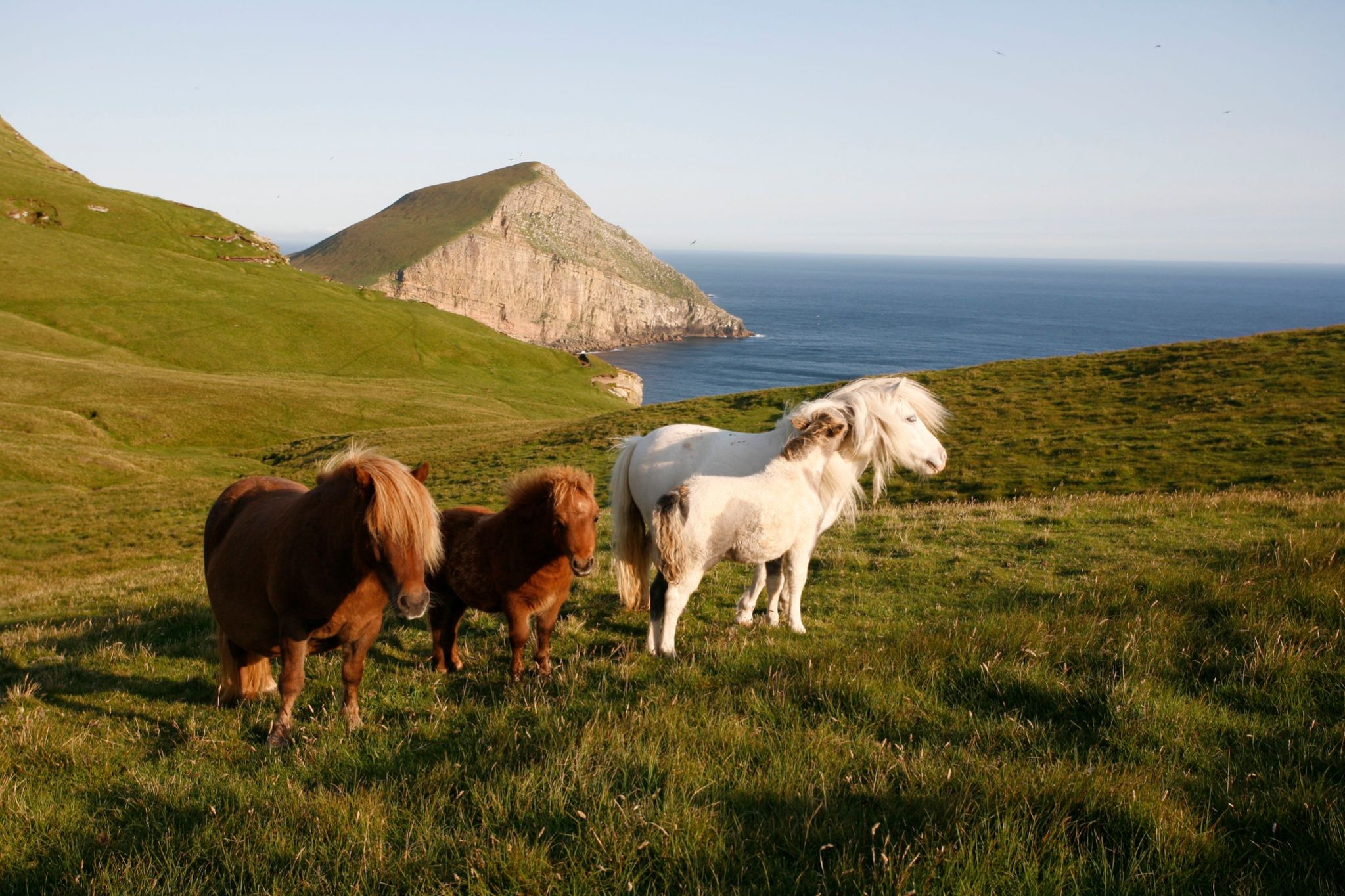
Shetland ponies roaming the hills on Foula
Shetland has a fascinating and unique natural environment, and today the islands are one of the most thrilling wilderness areas in Britain.
Shetland's world-famous small ponies can be seen throughout the islands - grazing by the roadside, on the beaches or on the heathery hills. They are all owned and tended to by local crofters, and can generally be seen in the West Mainland, Scalloway, Tingwall, Dunrossness and the island of Unst.
Shetland is a brilliant place all year round to watch sea mammals, particularly common seals. Walk along the coastline or take a stroll across a quiet beach and you’re bound to see an inquisitive head popping out of the water. Between May and August, you may be lucky enough to see orcas ('killer whales') hunting seals close inshore, or a school of white-sided dolphins chasing a shoal of fish or even a minke whale. Other species seen occasionally are pilot whales, basking sharks, sperm whales and Risso's dolphins.
Try Your Hand at Kayaking Shetland
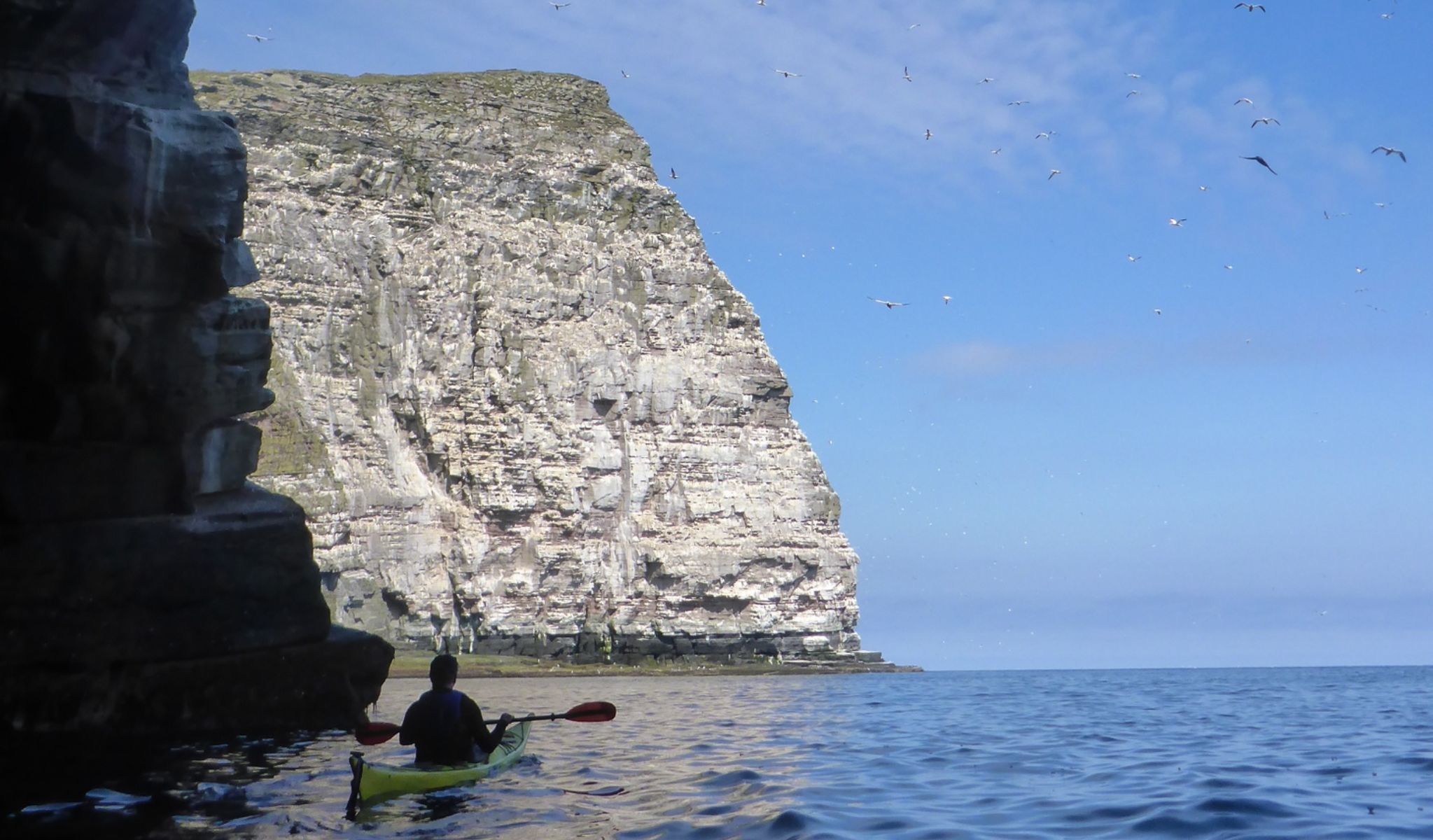
A kayaker at the cliffs of Noss
Shetland is an excellent place for an active holiday. If you really want to get to know the islands, there is only one way to do it – get out and get walking. The combination of spectacular coastal scenery on both North Sea and Atlantic facing cliffs, quiet inland lochs, and gentle heathery hills is unsurpassed.
The archipelago is also a great cycling destination, with many quiet roads in excellent condition for cycle touring, and there are bike hire shops in Lerwick, with electric, road and mountain bikes available.
If you’re more of a water person, the region’s extensive and accessible coastline offers endless opportunities for sea kayakers. Uninhabited islands, deserted beaches and countless sea caves are all waiting to be explored around Shetland by kayak. And for a bit of an adrenaline-fuelled surf or a paddle, opt for a surf or SUP (stand-up paddle boarding). There is also a variety of diving experience available, with countless caves, bays, stacks, natural arches, and shipwrecks.
Get a Taste of Traditional Seafood Shetland
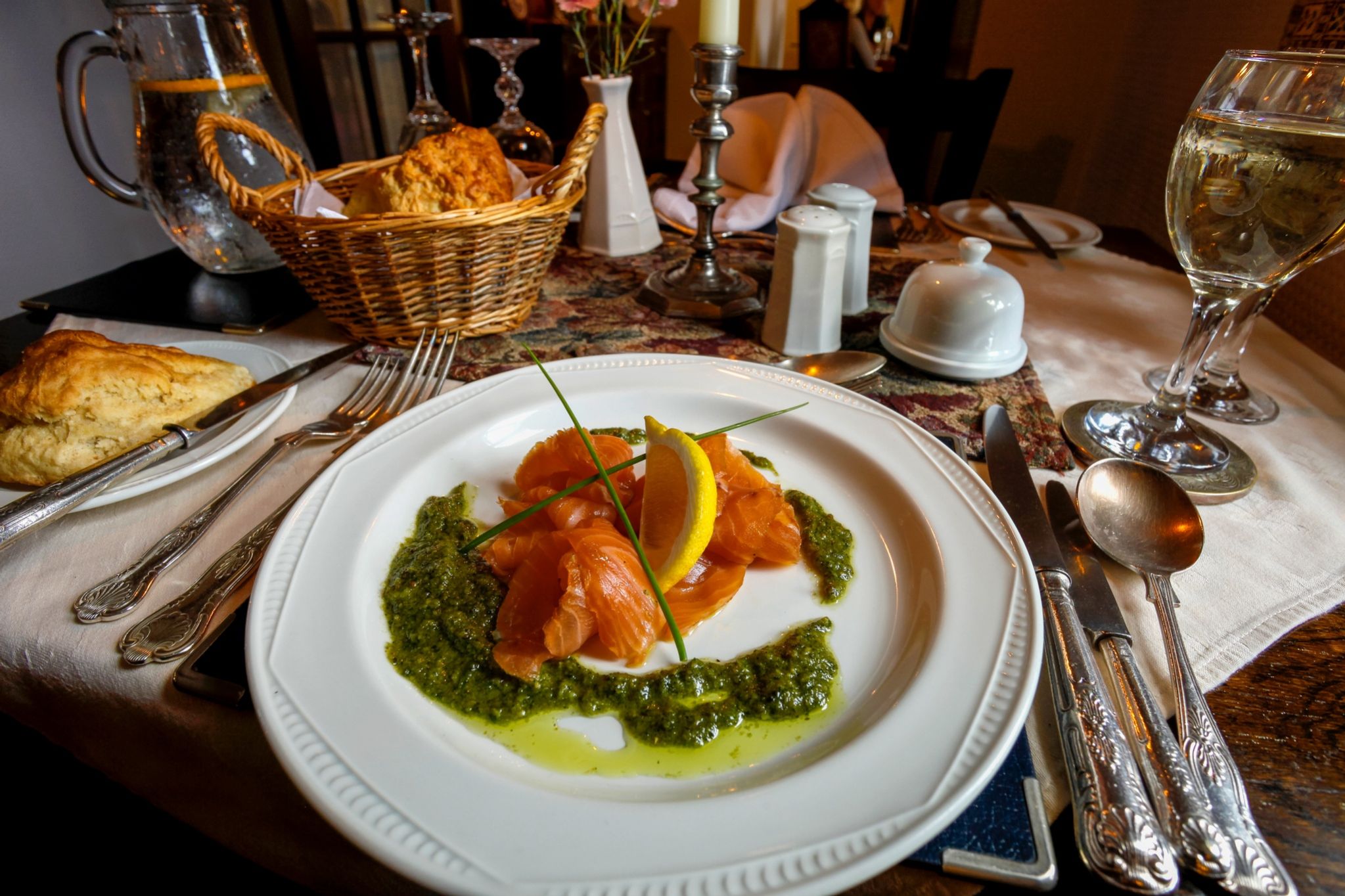
Smoked salmon served at the Busta House Hotel
Thanks to one of the most pristine environments, the food and drink produced in Shetland are exceptional.
Sample Shetland mussels at the famous, award-winning Frankie’s Fish and Chips on the shores of Busta Voe, or at Fjara Café. The wild, clean waters of the North Atlantic also mean you’ll find the freshest tasting herring, mackerel, and salmon.
There is also native beef produced in Shetland that is worth seeking out for a truly authentic flavour. It can be purchased at Anderson Butchers and the Scalloway Meat Company, and you may also find it on the menu at Caffe Volare, C'est La Vie, Da Steakhouse, Scalloway Hotel and more.
Experience Europe's Largest Viking Fire Festival Lerwick

Up Helly Aa Exhibition
Join thousands of residents as they take to the streets, dressed in sheepskins, wearing winged helmets and fur-trimmed tunics, carrying axes and shields, and brandishing flaming torches. The people of Shetland are certainly a fiery lot and know how to throw a party.
Taking place annually on the last Tuesday of January in the town of Lerwick, the Shetland’s Viking Fire Festival, or Up Helly Aa as it’s known locally, is the largest event of its kind in Europe. Thousands of visitors from across the world travel to this northernmost corner of Scotland to join in these Scandinavian Viking-style celebrations of the end of winter and the return of the sun.
The months of February and March will see plenty of smaller fire festivals throughout the islands. They may vary slightly in custom, but all embrace the islands’ Viking past and involve setting Viking longships on fire.
See The Dancing Northern Lights Shetland
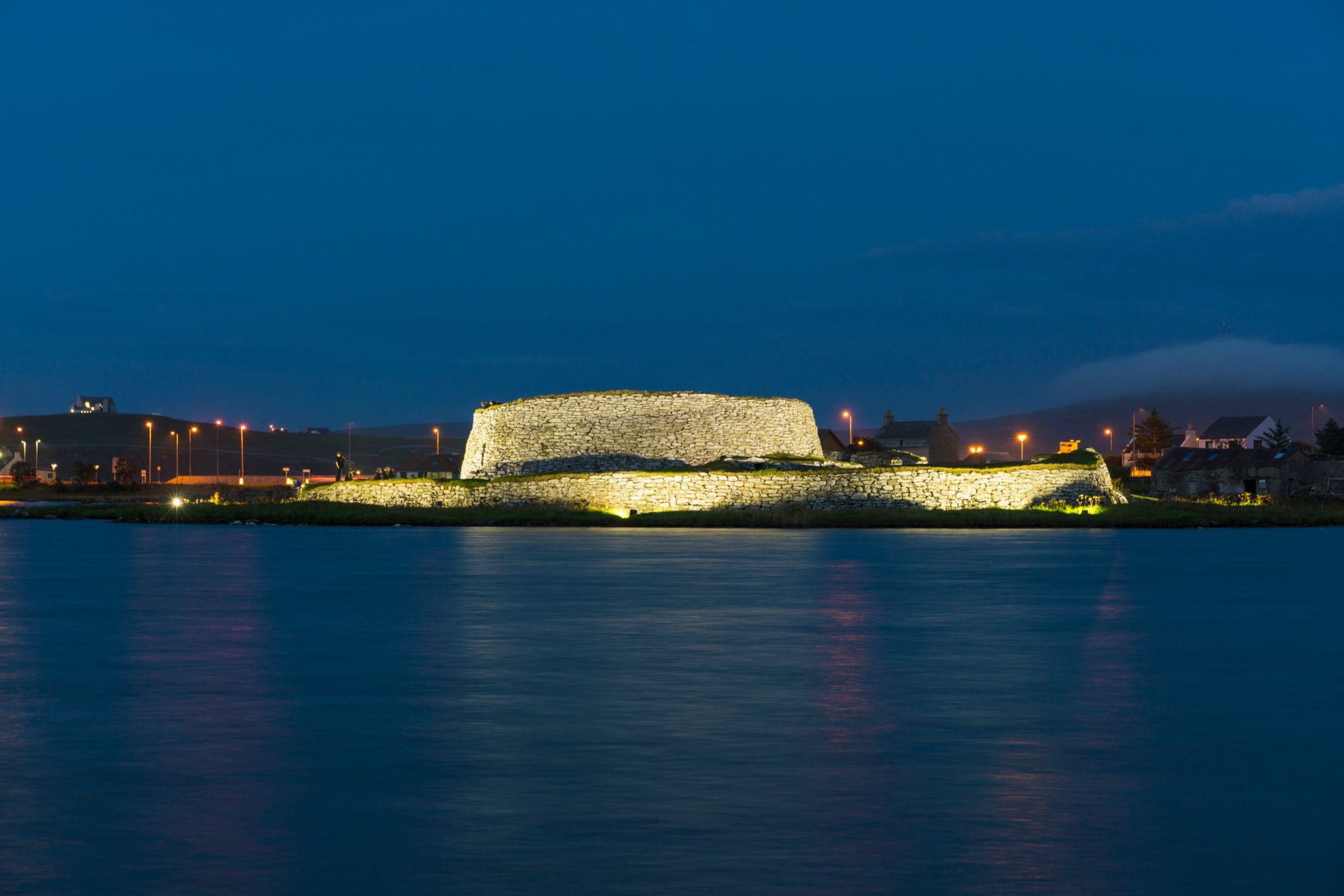
Clickimin Broch in Lerwick at night
One of the great experiences during the Shetland autumn and winter is the 'Northern Lights', or Aurora Borealis, known locally as 'The Mirrie Dancers'. Did you know that Shetland lies closer to the North Pole than any other part of Britain, making it one of the best places to see the northern lights in Scotland? In fact, visit these remote isles and you’ll actually be closer to the Arctic Circle than to London by about 200 miles (320 kilometres)!
There is an abundance of open countryside on Shetland so there are plenty of places to pull up and settle down for a leisurely light-spotting session. And, of course, you should move away from areas with street lighting, particularly Lerwick, to have the best view. Those who get to see them will be enchanted by the curtains of green, yellow, blue and red light swaying and shifting in the night sky.
The important thing to bear in mind is that aurorae are hard to predict, and you should use the Aurora Watch UK service to receive alerts of when the aurora might be visible from the UK.
Go Island Hopping Shetland
Braewick Caravan & Campsite
Go for a journey off the beaten path. In fact, ditch the path altogether, hop on a boat and do some proper island-hopping. Shetland with its white sandy beaches and clear seas is a great place to hop around – with over 100 to choose from, you’ll be spoilt for choice! Each of the 10 populated islands (that includes the mainland) offers something unique for visitors to experience.
Witness the incredible sight of thousands of seabirds on cliffs at nature reserves, such as Hermaness. Unearth the history of the Viking era on Unst. Enjoy lively folk music sessions in pubs in Lerwick and try locally produced spirits and ales. Visit the southerly Fair Isle; head West to Foula, often referred to as the Edge of the World, or head East, to Out Skerries, which is only two miles square. Then there's the uninhabited islands, which don't have ferry services. Mousa, famous for its broch can be visited during summer months via the Mousa Boat, while Hildasay, Oxna and Havra are accessible from Scalloway.
Witness the Volcanic Wonder of The Eshaness Cliffs Shetland

The Eshaness Cliffs
Did you know that Shetland has UNESCO Geopark status, meaning that it has an outstanding geological heritage? Due to the lack of trees and the abundance of stone, Shetland has some of the best-preserved archaeology in Europe. Beneath your feet are some of Britain's oldest rocks. Explore the Shetland Geopark and you’ll discover not just the story of the islands, but the story of how the world has formed and changed over millions of years.
For unrivalled breathtaking beauty, geology and archaeology, set off on the volcanic trail at Eshaness. Located about an hour’s drive from Lerwick, Eshaness is an exposed peninsula in the north-west Shetland mainland. Blasted by the full force of the North Atlantic, it displays a stunning array of stacks, blowholes and narrow inlets.
Find Evidence of Viking Settlements at Haroldswick Shetland
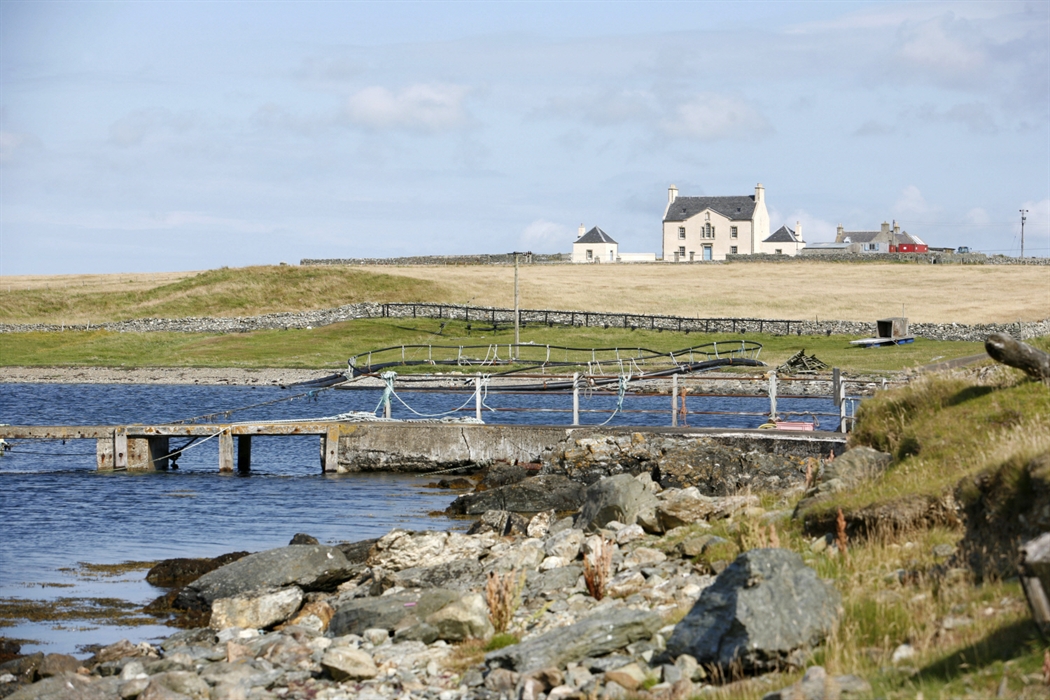
Belmont House, & Wick of Belmont, Island of Unst, Shetland
There is a strong tradition of Vikings living in Shetland. In the south of Shetland, there’s evidence of a Viking settlement at Jarlshof, one of the most important and inspirational archaeological sites in Scotland, and Old Scatness, where you’ll find an Iron Age broch and village. But it’s in Britain’s northernmost inhabited island, Unst, that you’ll find the greatest concentration of evidence of the Viking raiders’ presence and subsequent Norse occupation.
Haroldswick means ‘Harold’s bay’, named after Harald Fairhair who reputedly landed in this beautiful inlet. Just south of the settlement, you can step aboard a full-scale replica of the 9th century Viking longship, the Skidbladner. She is one of the largest replica Viking longships ever built. There is also a longhouse replica, that’s based on the floorplan of one of the best preserved and excavated longhouse sites at Hamar.
Nearby is the Unst Heritage Centre, which serves both as a museum and a community centre. Here, explore exhibitions about past and recent Unst life, including information about the Vikings and various excavations in Unst.
Follow The Shetland Craft Trail and Stop at Mareel Lerwick

If you’ve been inspired by Shetland’s dramatic scenery, then you might fancy going on a journey to discover the islands’ creative side. Stop at Mareel, the UK’s most northerly music, cinema and creative industries centre – perfect for embracing the art, or simply just relaxing with a coffee enjoying the view and watching the seals and seabirds bobbing just outside the windows.
Or follow the Shetland Craft Trail and explore the local art scene and visit craft workshops and open studios, from Unst in the north, to Scousburgh and Fair Isle in the south. Join workshops and tuition in traditional and contemporary textile crafts, hand-spinning, knitting, or weaving, or book a tour with an experienced operator – they'll show you the tools and techniques employed to create products like authentic Fair Isle knitwear. You’ll also have a chance to meet the artists and designers, commission special pieces, or simply shop for unique gifts. Why not visit during Shetland Wool Week? This internationally acclaimed event is one not to miss, as it boasts an extensive range of exhibitions, classes and more.
- Hearing Loop
- Accessible Parking Or Drop-off Point
- Level Access
- Accessible toilets
- Cafe or Restaurant
Join a Guided Tour and Get Insider Knowledge Shetland
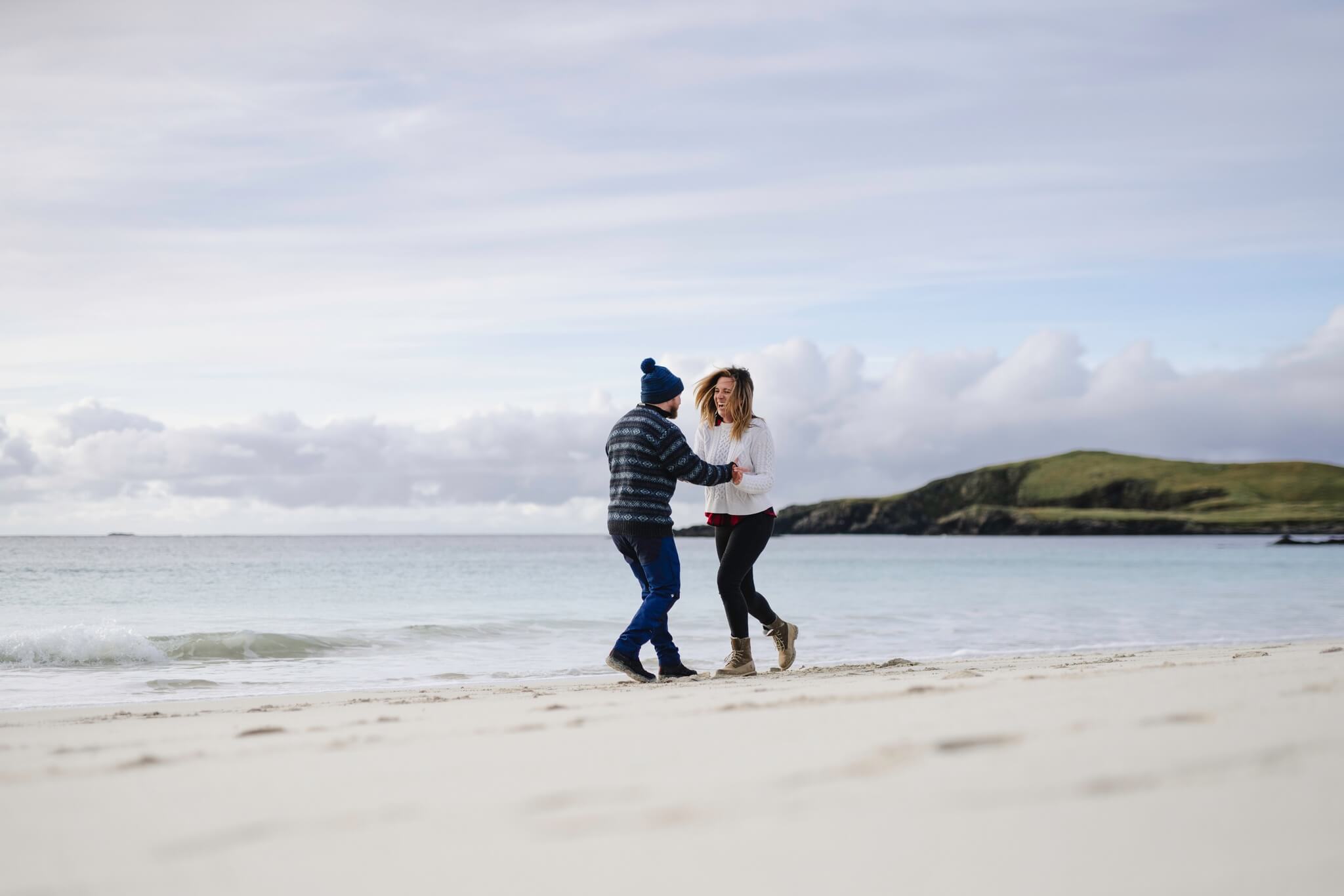
A couple on the beach at Meal Beach in Burra, Shetland
If you have a week, a couple of days or even just an afternoon, Shetland has a range of tour operators offering trips on both land and sea and there is no better way to discover the magic of Shetland than on a guided tour.
From seeking out special winter wildlife visitors to getting a glimpse into the fascinating history of the islands, ther are also full day trips to the island of Foula to see the cliffs to specialised photography or wildlife watching tours You can pick and choose the things you'd like to do to create your ultimate Shetland experience. Bespoke tours can be designed and tailored to suit your requirements. Get in touch with the tour guide of your choice to discuss an itinerary which will leave you chomping at the bit to get there.
Play Britain's Northernmost Golf Course on Whalsay Whalsay
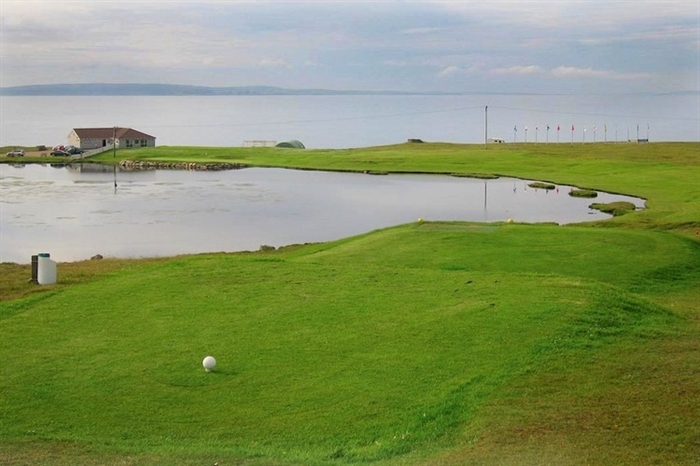
Whalsay Golf Club
What makes Whalsay Golf Course truly one of a kind? It's not only the tranquil surroundings coupled with the treacherous golfing challenges, but also the fact that it’s the most northerly course in the UK. Featuring some superb clifftop holes, this 18-hole course is located on the small island of Whalsay. Bordered by the sea on both sides, it is surrounded by spectacular coastal scenery, which is host to an abundance of wildlife.
And how about a round of golf at midnight, during the summer months? You can tee off all around the clock thanks to the endless hours of daylight.
There are three golf courses in Shetland. The best 18-hole golf course is Asta Golf Club, located in the fertile and historic valley of Tingwall, not far from Lerwick. The largest with most enthusiastic membership is Shetland Golf Club.
Take the Kids to the Crofthouse Museum Lerwick
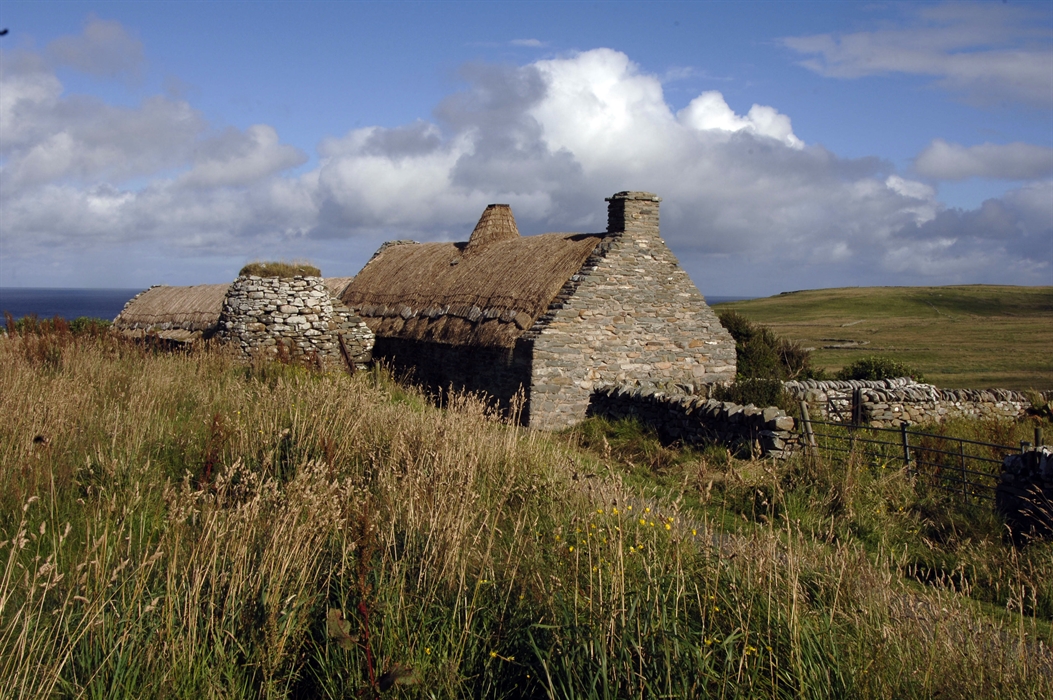
Historical Shetland Crofthouse Museum
In Dunrossness you’ll find the Shetland Croft House Museum where the kids can step back in time and see how a traditional family would have lived in the 1870s.
There's no shortage of things to do with children in Shetland – all you need is a bit of time and plenty of imagination. Get up close and personal to the beautiful Shetland ponies at the Shetland Pony Experience. Here children can ride these beautiful animals and all the family can help groom them.
Go back in time at Scalloway Museum – a real treat with the kids. There’s plenty here to keep children captivated from artefacts revealing the islands whaling past to the role it played in the Second World War. Shetland’s Museum & Archives building in Lerwick is absolutely jam packed with artefacts from across the islands and through time. There are boxes for dressing up and lots of opportunities to get interactive with the displays.
Shetland Fiddle and Music Festivals Shetland

Mareel, the UK s most northerly music, cinema and creative industries centre.
Shetland’s music is more diverse than many outsiders might imagine, encompassing everything from groove metal to jazz, classical, rockabilly, funk, prog-rock and even Balkan klezmer. As you’ll soon discover, Shetland's fiddle music is only one example of a rich oral tradition.
If you want to listen to live music in Shetland, Mareel and Clickimin host regular gigs with local and visiting artists. Shetland’s modern network of country halls also handles many musical events and there are regular jam sessions in local pubs.
Shetland for a Rainy Day Shetland
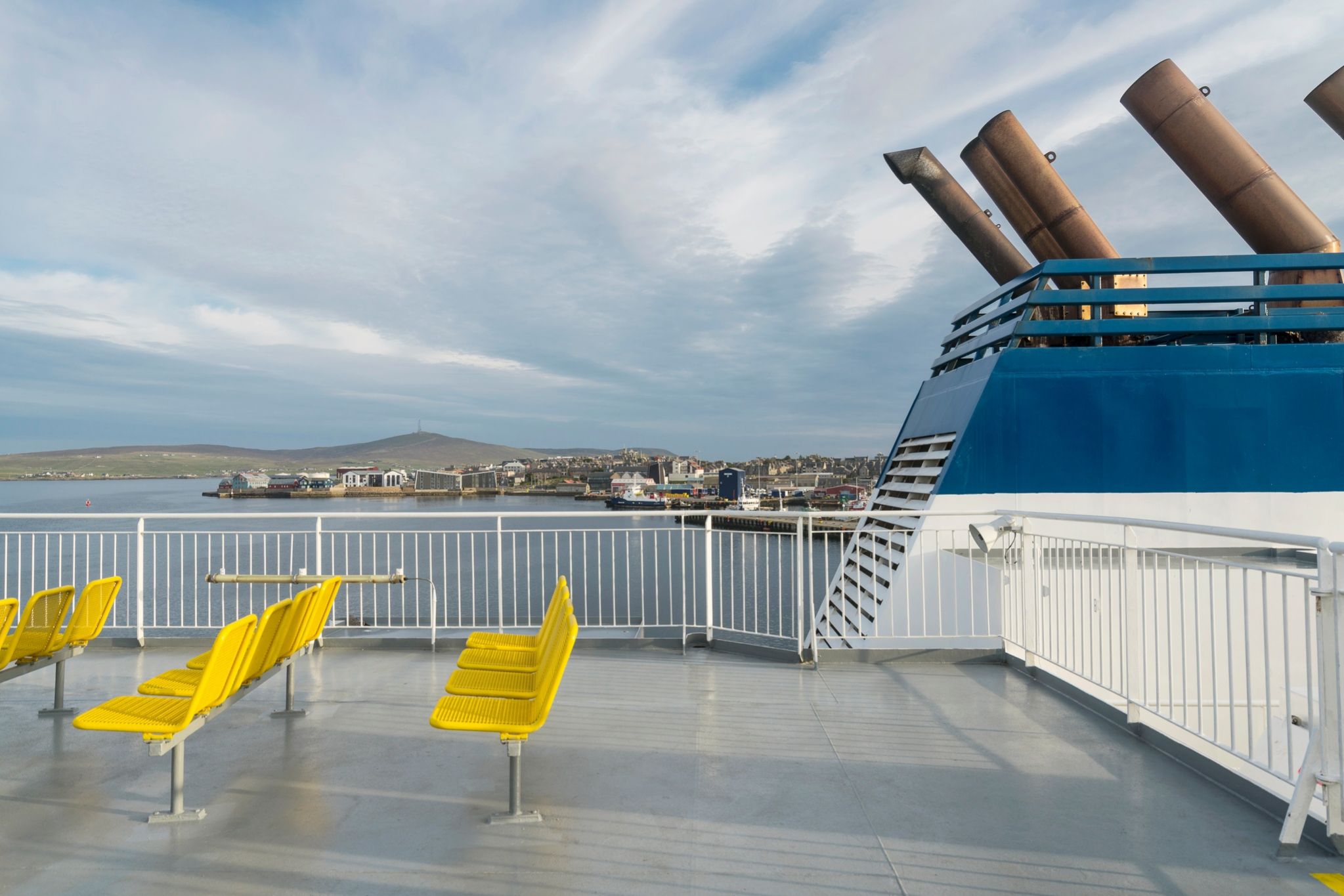
Lerwick ferry
What things can you do when it’s a rainy day in Shetland? We've got a few ideas that might help.
See the best of Shetland’s artists at Bonhoga Gallery. Situated within Weisdale Mill – a watermill in the central mainland, the gallery is a superb place to see the best of Shetland’s artists. It also has a super shop full of tasteful souvenirs and a marvellous café.
At Tangwick Haa Museum, you can find out about Shetland’s past. This lovely museum was built in the late 17th century and today houses a fine collection of early agricultural tools, 19th century household objects and other artefacts and photographs documenting life in Northmavine through the years.
Alternatively, why not visit the Up Helly Aa Galley Shed and see some of the amazing Viking costumes and galleys created for the yearly event?
Shetland is also famous for fantastic swimming pools with slides. The Clickimin Leisure Complex holds the biggest versatile space within Shetland, catering for the isles ever-growing sports calendar and for large and small-scale concerts and cabaret events.
Find experiences
JavaScript needs to be enabled to see this product search form. You can turn this on in your browser settings.
Other things you might like
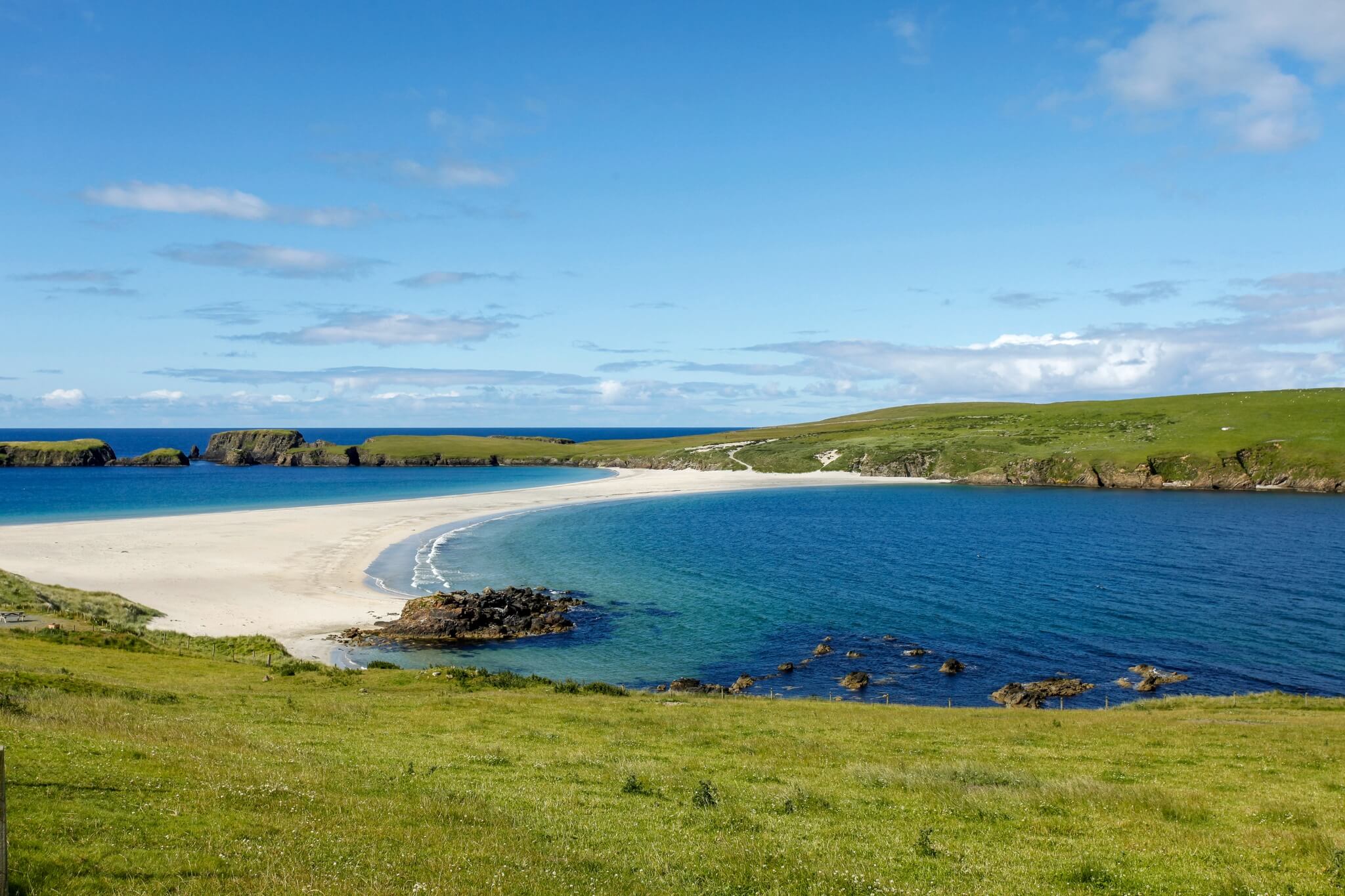
Scottish Islands & Island Hopping

9 Iconic Scottish Spots with Hidden Gems Nearby

Eco-Friendly Accommodation in Scotland

Shetland Ponies: A brief history
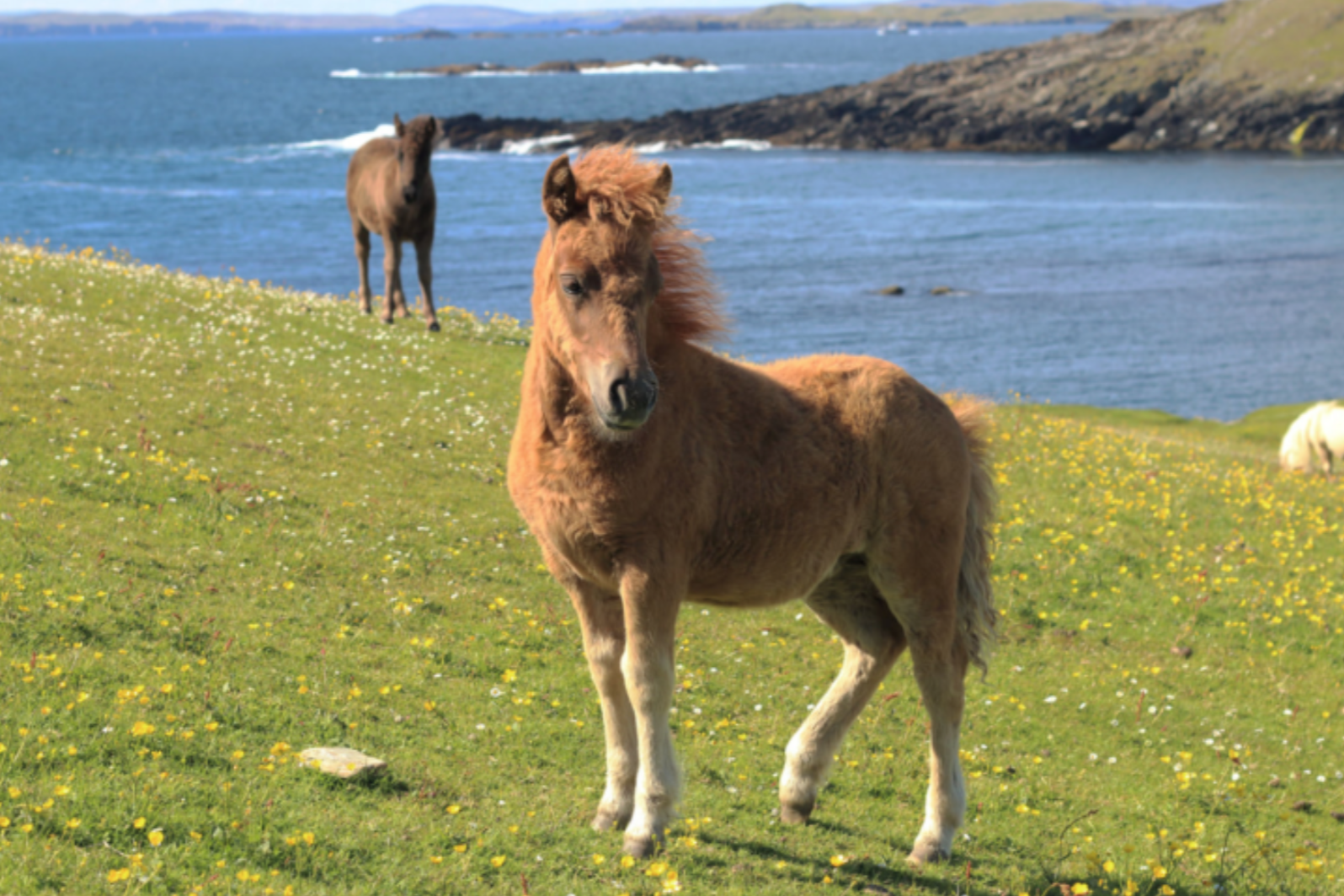
“A little barrel-bellied broad-backed equuleus, of a brown or black colour, that is no larger than a donkey”
This is the description of a Shetland pony, written by Samuel Hibbert on his tour of Shetland in 1822 after encountering the native breed of pony, unique to Shetland.
The discovery of a leg bone in excavations at Jarlshof demonstrate that ponies date back as far as the Bronze Age, some 3-4,000 years ago; evolving into a breed which is unique to Shetland. This blog will explore the history of this fascinating breed and their use today.
Shetland ponies are most-notably very hardy, stout, strong and sure-footed. They have adapted remarkably well to Shetland’s often harsh environment, and as a result, need minimum care. They are able to live happily outdoors all year-round and they prefer the rough grazing which dominates the landscape.
Adapting to the harsh climate in several ways, they are small and stout, ranging between 28 and 42 inches, they also have large feet, perfect for negotiating boggy ground, and a double-layered coat of hair ensures they are entirely waterproof, warm and dry in winter. This coat is shed in the summer and can make the pony look a bit shabby as they moult!
Hibbert’s description of the winter coat and their sometimes scruffy outward appearance is worth noting. He says that “the long shaggy hair with which he [the pony] is clothed, has more the appearance of a Polar dress, or of some Arctic livery, specially dispensed to the quadruped of Hiatland [Shetland]” He also describes the mane as one that “no comb was applied” and “it was left to nature’s care, ‘ruffled at speed, and danc’d in every wind”.
Their unkempt appearance is often noticed by visitors and I’m often asked if the ponies are neglected. They are certainly not neglected, every pony in Shetland has an owner and they are very well caerd for, each one being micro-chipped and even having individual pony passports! Their rugged appearance this is actually one of their unique defence mechanisms, specially developed to suit the environment in Shetland and, once the winter coat is shed, the short summer one has a beautiful silky-sheen.
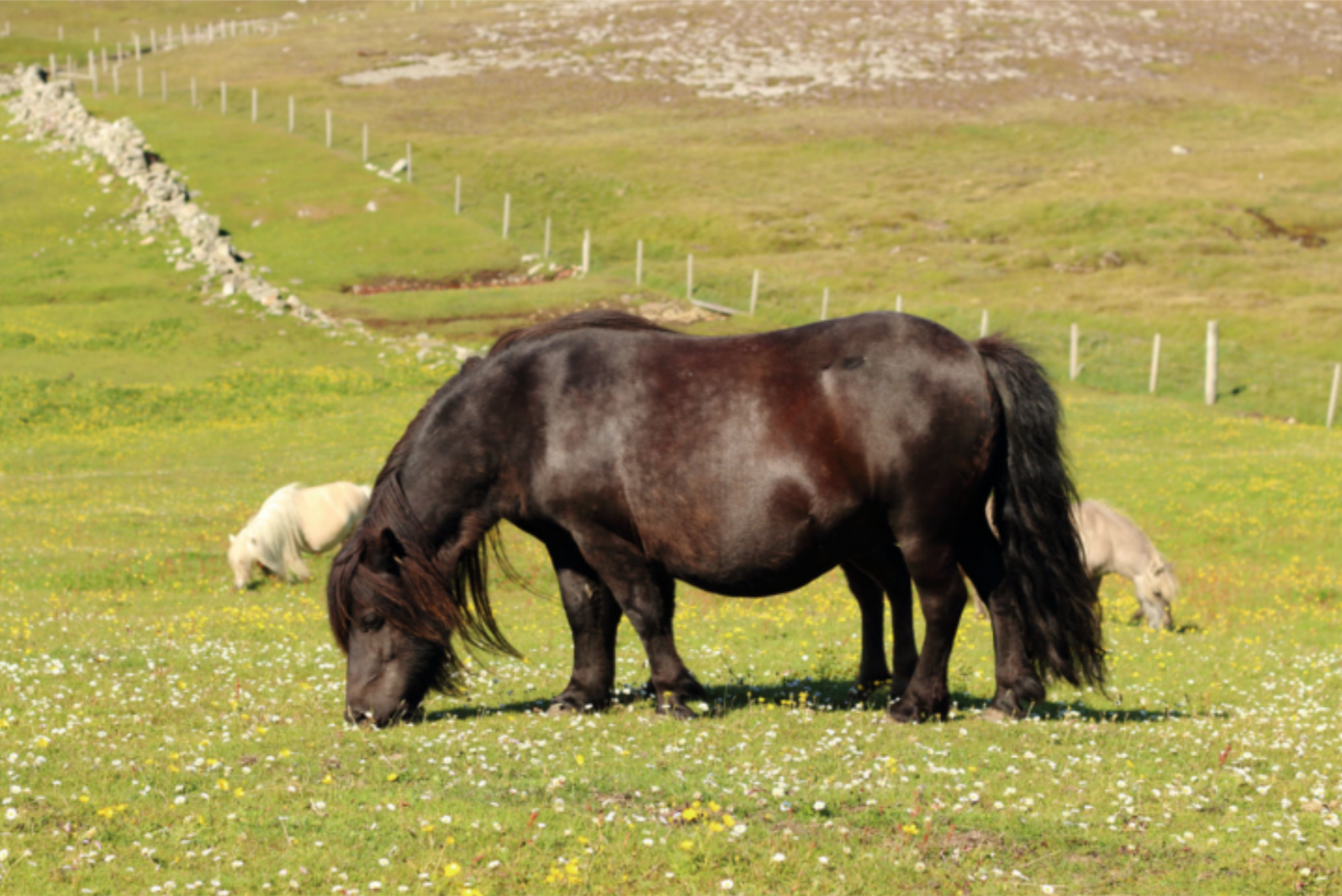
There are three types of Shetland pony; miniature (28-34”), midi (34-38”) and standard (38-42”). They come in all different colours and pattern, although never will the colouration and pattern be leopard-spotted. Most common colours include named variants such as skewbald (red and white) and piebald (black and white) black, bay and chestnut.
Ponies are long-lived with many reaching into their 30s and beyond, one of the most common problems is that they develop a condition called laminitis which occurs if they are fed a diet too high in non-structural carbohydrates – in other words, they can’t have too much green grass in summer! The rough grazing provided from a Shetland hillside is ideally suited to allow them to thrive.
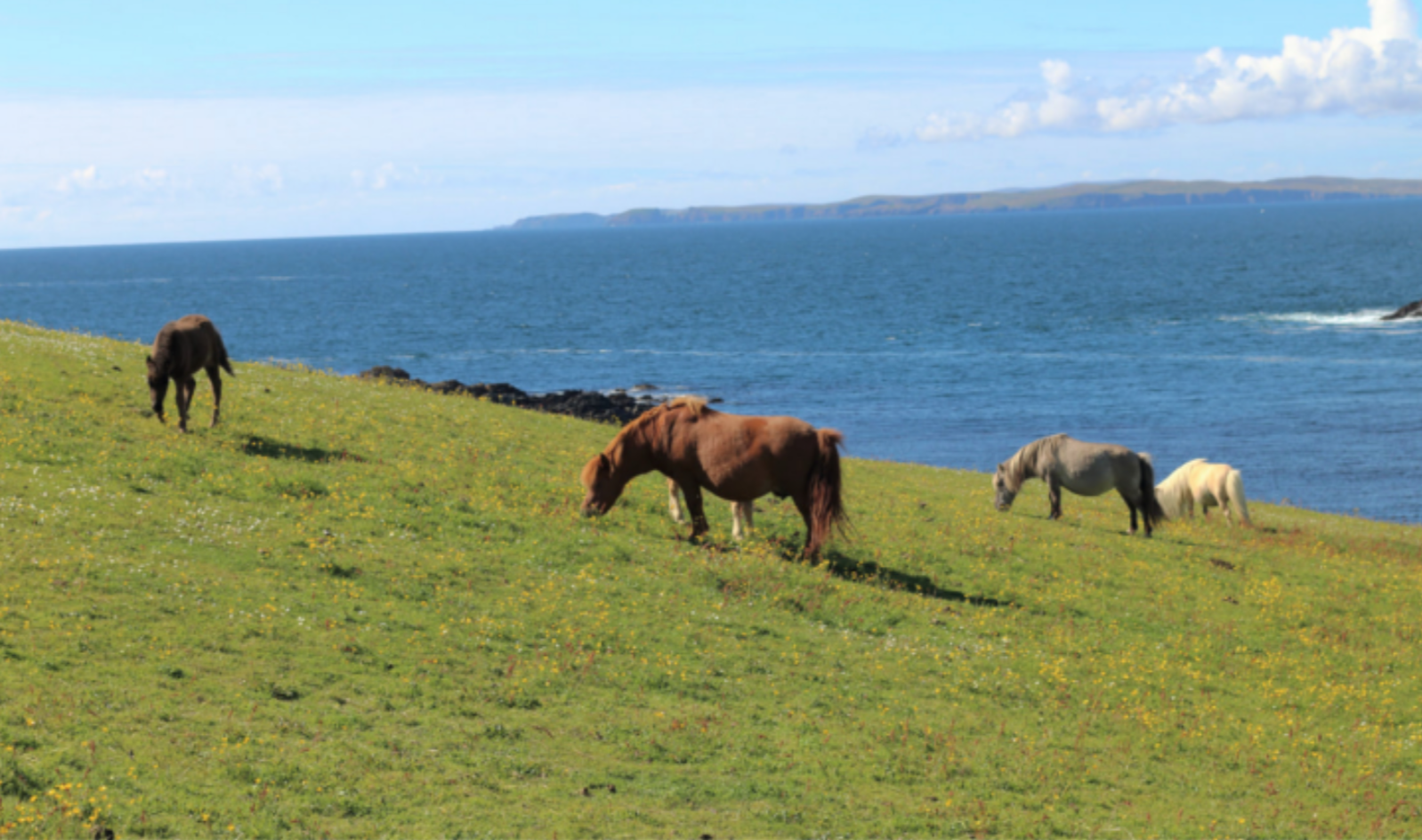
Traditionally ponies would have been used on the croft [traditional smallholding] for general-work; tasks such as carrying, especially peat, which was used for burning for heating and cooking (see blog about peats ). Oxen were the preferred choice for ploughing, although not exclusively used as ponies could pull ploughs too. In the days before our road network, ponies provided good transport overland where a boat couldn’t be used.
Ponies were also exported to overseas markets and used in mines – their small stature and strength making them perfect in narrow confines and mine shafts. In the 1850s new legislation banned the use of children in coal mines. As a result, ‘pit-ponies’ were introduced to mines. Black, male Shetland ponies were the ideal ‘small-horse’ for the job as they were very strong, capable of carrying twice their own weight and able to fit into narrow, dark and dusty mine-shafts. George Low (visiting Shetland in 1774) described them as being “excellent work beasts, capable of enduring much fatigue”.
Over the years,thousands of ponies were sent to the mines throughout Britain and America, working underground, hauling carts. The last mine using ponies closed in 1971 and was in America.
During the 17th and 18th centuries, ponies were hired out to Dutch fishermen at a rate of a stiver a mile to provide the seamen with some exercise. Doctors who travelled with the Dutch fleets encouraged this type of activity for the men who went ashore after months at sea. One incident tells of a tragic accident when one of the ponies failed to stop whilst racing up to the Knab in Lerwick. Both rider and pony went over the cliffs and to this day, the spot is still known as the ‘Dutchman’s leap’.
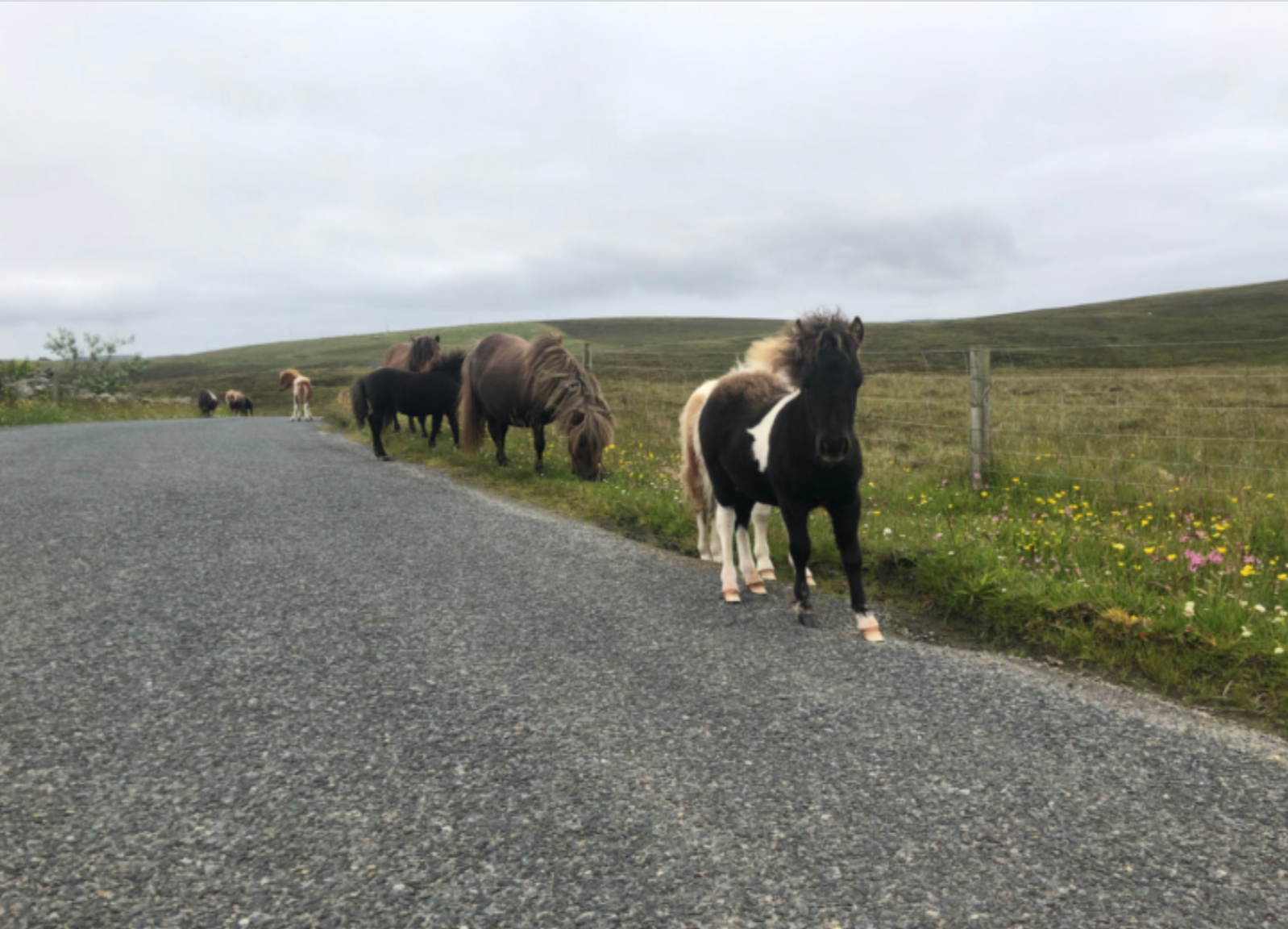
As with any breed, regulations keep close scrutiny on the stock and ensure that the breed remains true. The Shetland Pony Stud Book Society was formed in 1890 with an aim of ensuring purity and retaining a high-quality animal. ‘Jack of Noss’ was the first pony to be logged in the Stud Book and most ponies today can be traced back to his ancestry. Noss (an island off Shetland’s east coast, at the back of Bressay) was a large pony breeding stud in the 19th century. Operated by the Marquis of Londonderry, they exported the majority of ponies from Shetland at that time, although other studs did export, including many from Berry Farm in Tingwall. Today every pony bred in Shetland must have a microchip and passport in order to confirm authenticity.
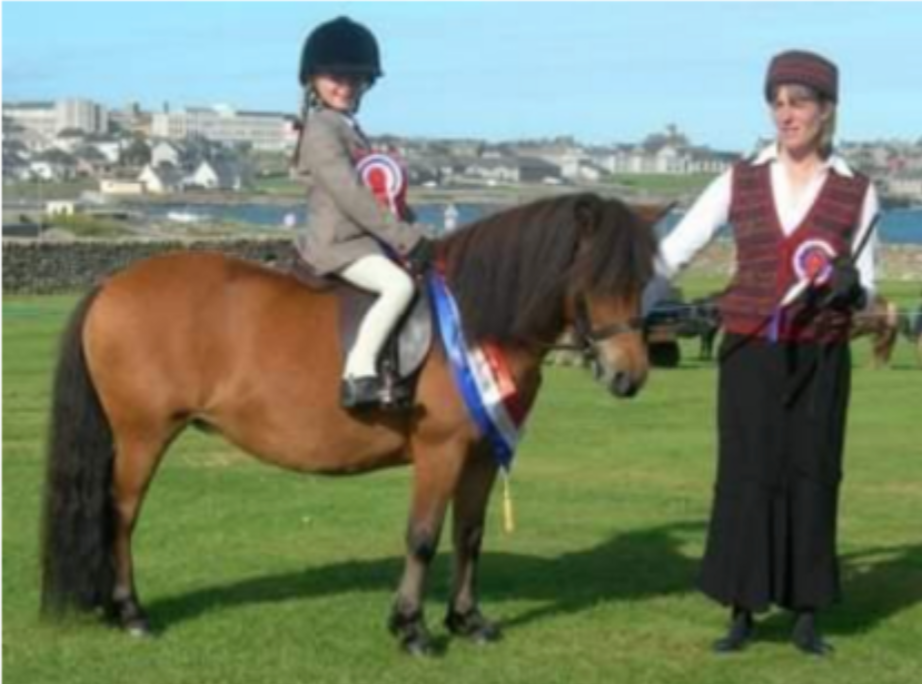
Shetland ponies are still immensely popular today, with over 100 breeders still active and around 1,000 ponies in the islands. Although mechanisation has replaced them on the croft, they are still used for riding. They are very good for teaching children how to ride as they are small, gentle and (generally!) good-tempered, providing a good starting point for those wishing to ride.
Shetland pony competitions are common with many youngsters participating in riding competitions, both within and outside Shetland. Shetland riders also participate in the annual ‘Shetland Pony Grand National’ at the Olympia Stadium in London.

Melody Goodlad competing at Olympia in 2012 on her Shetland pony.
Shetland ponies also make very good companions for horses. They are sociable creatures and enjoy the company of other ponies or horses. But most of all they are known for their cheeky temperament and good-natured personality – along with a big dash of stubbornness thrown in for good measure! My cousin Bronagh, who has ridden horses and ponies since she was a toddler, says that “They're well known for being very cheeky, if any of our horses were going to escape the park or take a nip at you it was the Shetland, and I've seldom fallen off our horses, but the Shetland kept us on our toes and you learnt to ride well because you quickly learnt how to stay on!”
Today ponies can still be seen extensively throughout Shetland. They often appear to roam wild, seen in the hills, the roadsides, beaches and heathery hills, although, despite this, they are all owned and tended to regularly. Foals are born in May and can be sold at six months old when pony sales are held in October. One quote which sums up the pony perfectly is that they “are foaled in the fields, live in the fields and die in the fields”.
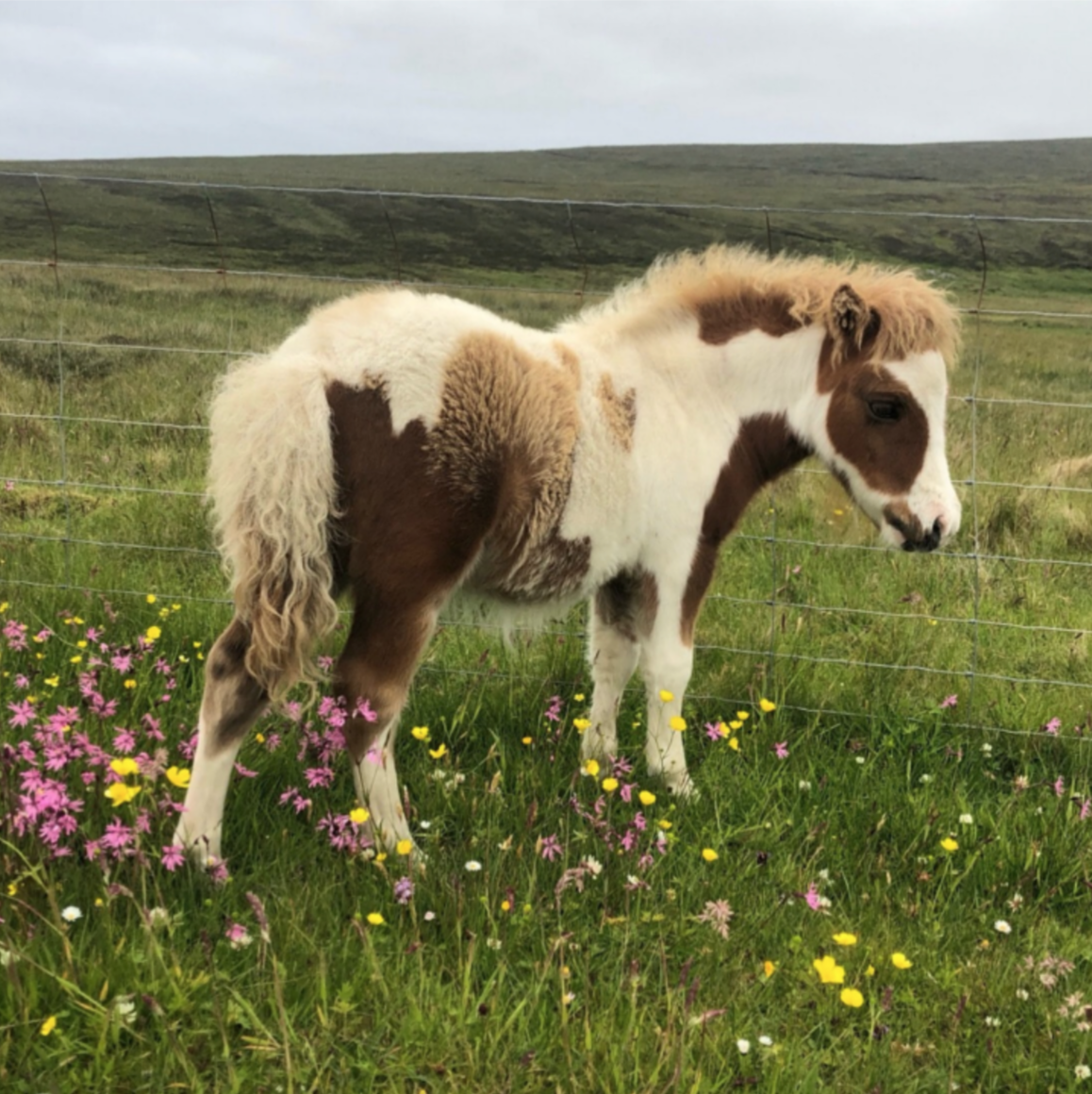
Ponies popularity with visitors means that they are often used in tourism. There is very little money in keeping ponies generally, but some are used as attractions for visitors to see and that helps pay for some of their annual upkeep. But, most of all, they are kept out of love for the breed and the desire to maintain the lineage bred from Jack of Noss.
Despite their small stature and unassuming nature, these small native ponies remain one of the most easily recognisable, iconic creatures, readily associated with Shetland. The fact remains, many people will know a Shetland pony to see yet will have little idea about the ‘Shetland Islands’, these guys truly are world-famous and will continue to thrive on the hillsides of Shetland for many generations to come.
Until next time,

“Visitors want to have the best experience; they want to see Shetland through the eyes of a local. They want to taste the salt on their faces, smell the sea and bear witness to the wind in their hair. They want to drink in the sights, the smells and the sounds of an island community. They want to be shown the places they would otherwise not discover. They want to piece together the fascinating jigsaw and truly discover Shetland; this is the trip they have dreamed of.”

A walk to Tingon, Northmavine
Shetland and the dutch-east indiamen.
Shetland Pony Breed Profile
Training, Grooming, and Care Tips
BiancaGrueneberg/Getty Images
Shetland Pony History and Origins
- Breeding and Uses

Colors and Markings
- Characteristics
Diet and Nutrition
- Health and Behavior
Pros of Shetland Ponies
Cons of shetland ponies.
- Notable Horses
- Shetland Pony for You
- How to Adopt or Buy
More Horse Breeds
A Shetland pony (or a Shetland mix) is strong enough to be ridden by children and gentle enough to be kept as a pet. Although diminutive, Shetlands are strong, intelligent, gentle, and a bit wily. They can be very cheeky, which can make them fun but headstrong.
There's also no disputing the cute factor, but don't let that fool you. These are hardy little ponies that are capable of outworking the largest draft horse.
Learn more about the Shetland pony, from the breed’s history to their temperament and care needs.
Breed Overview
Weight: 400 to 450 pounds
Height: 7 hands (28 inches) to 11 hands (44 inches); up to 11.5 hands (46 inches) for American Shetlands
Body Type: Compact body; broad head; thick neck; short legs; lush mane and tail
Best For: All levels of owners and riders, including children
Life Expectancy: 30 years or more
Click Play to Learn More About the Hardy and Versatile Shetland Pony
The true origin of the Shetland pony has been lost to time. As many as 4,000 years ago, ponies were roaming the rugged Shetland Islands off Scotland. The Celtic pony likely figured into the breed, along with potential crosses with the ponies of Norse settlers.
Resilient and strong, Shetland ponies were used to pull carts and plow farmland, among other jobs. During the Industrial Revolution, they were sent down into mines to help haul coal . They also become popular companions for children, thanks to their gentle disposition and size.
The Shetland Pony Stud-Book Society formed in 1890 to register and keep track of the breed. The American Shetland Pony Club also registers ponies in the United States.
Shetland Pony Size
Registered Shetland ponies are a maximum of 10.5 hands (42 inches) at the withers. In the United States, the American Shetland Pony Club allows ponies up to 11.5 hands (46 inches). The weight of a Shetland pony depends on their height but generally is around 400 to 450 pounds.
Shetland Pony Breeding and Uses
In the harsh climate of their native land, with scarce food and rugged terrain, Shetland ponies developed into very hardy animals. They have thick coats that help them withstand frigid winters, and their broad bodies make them exceptionally strong. In the United States, breeders refined the ponies to be slightly leaner with longer legs. These American Shetlands are more agile and have a longer stride than the traditional Shetland pony.
They have been used extensively to pull plows, carts, and buggies. And in the 1800s and 1900s, they were known for working in mines in both Britain and the United States. Now, Shetland ponies are used for pleasure driving (pulling carts, wagons, etc.) and riding, and many are the companions of children in horse shows and may be kept simply as pets. In addition, wild herds still exist on the Shetland Islands.
These ponies shouldn’t be ridden by adults, as they are too small. They also make great companions for other horses.
Shetlands are almost every equine color, including pinto combinations (patches of white and any other color). But registered Shetlands cannot be leopard spotted like the Appaloosa . The most common coat colors include black, chestnut, gray, bay, brown, roan, palomino, buckskin, dun, cream, and champagne—with every variety of face and leg markings .
Unique Characteristics of the Shetland Pony
It is said that pound for pound a Shetland pony can pull more weight than the enormous Clydesdale . Besides the immense strength in their small bodies, Shetland ponies can also run 20 mph.
They also are known for their long lifespan, with many living more than 30 years. And, of course, they are highly recognizable for their short stature. Many other small breeds have Shetland ponies in their background, including the miniature horse, National and American show ponies, and the Falabella miniature horse.
It's far easier to overfeed a Shetland pony than to underfeed one. Because the breed evolved in such harsh conditions and had to search for nutrition, Shetlands can thrive on very little food. Rarely does a Shetland need grains or concentrates, which can lead to obesity. Good quality grass hay is ideal for them.
Common Health and Behavior Problems
In general, Shetland ponies don’t have many health issues. But their size can make them susceptible to heart problems, as well as laminitis. This is an emergency condition in which the hoof becomes inflamed and causes severe pain. There are many causes of laminitis, including overeating grain or lush grass.
In terms of behavior, Shetland ponies are typically friendly and gentle. But they can be a bit headstrong and uncooperative, especially if they aren’t trained.
Shetland ponies grow very thick, soft winter coats. Often they're the first to "coat up" in the fall and the last to lose their winter coats in the spring. The outer hair is coarse, and the undercoat is silky soft. They require standard equine grooming of regular washing, brushing, and combing. And their hooves ideally should be cleaned and checked daily for dirt, debris, and any injuries.
- Hardy and strong
- Good with children
- Intelligent
- Sometimes stubborn
- Prone to laminitis
- Easy to overfeed them
Champion and Celebrity Shetland Ponies
The Shetland pony's longevity has resulted in several claims of the world's oldest pony. For instance, a pony named Twiglet died in 2017 at age 50.
These ponies also have had their time on the silver screen. In a 1976 Disney movie called The Littlest Horse Thieves , three children plot to steal ponies from a mine after they find out the ponies are set to be killed as the mine is mechanized. This goes along with the Shetland's real-life history in mines.
Is the Shetland Pony Right for You?
Even-tempered Shetland ponies are good for owners and riders of all experience levels, including families with children, though they can be stubborn and require consistent training.
Because they’re so hardy and fairly independent, they’re typically easy to care for. They do well in cold, rugged climates like their native Shetland Islands. But owners must pay attention to their nutrition and avoid overfeeding, which can lead to laminitis and obesity, among other health problems.
How to Adopt or Buy a Shetland Pony
The average price for a Shetland pony ranges from around $500 to $1,500. The price typically increases for breeder ponies, especially when they can trace their purebred lineage.
There are many rescue groups that have Shetland ponies for adoption. A quality rescue group or breeder should be transparent with you about the pony’s disposition, health status, and history. The facility also should be clean and have appropriate housing for the animals. You should be able to spend time with a pony before opting to bring them home. Feeling rushed to make a decision could be a red flag that the organization isn't acting in the best interest of the animal.
It is highly recommended to have your veterinarian perform a pre-purchase or pre-adoption examination to confirm the pony's health and suitability for their intended use.
If you’re interested in similar breeds, check out:
- Miniature Horse
Otherwise, you can check out all of our other horse breed profiles.
In addition to sometimes being uncooperative, Shetland ponies are easy to overfeed, and that can lead to health problems. They are susceptible to laminitis and heart issues.
Shetland ponies are small, so adults shouldn’t ride them. However, young children can ride them.
Yes, Shetland ponies make good pets for horse owners of all experience levels, including kids.
More from The Spruce Pets
- Miniature Horse Breed Profile
- The 12 Smallest Horse Breeds From Around the World
- 10 Best Driving Horse Breeds for Pulling a Carriage
- Welsh Pony and Cob Horse: Breed Profile
- 10 Best Horse and Pony Breeds for Kids
- Gypsy Vanner Horse Breed Profile
- Morgan Horse: Breed Profile
- 10 Most Popular Horse Breeds and Types of Horses
- Appaloosa Horse Breed Profile
- Dartmoor Pony: Breed Profile
- Mustang Horse: Breed Profile
- Percheron Horse: Breed Profile
- Akhal-Teke Horse: Breed Profile
- How Many Horse Breeds Are There in the World?
- The Difference Between Horses and Ponies
- Hackney: Horse Breed Profile
- The Shetland pony dream team
- Inspiration
Norwegians Bjorn Larsen and Tore Skarpnord are partners in life and Shetland pony breeding. They share the secrets of their life in Shetland – and why their partnership works.
NB: This article was written in 2018, and some details have changed.
Up on a marshy plateau, about as far west as you can go in Shetland, it’s a chilly November afternoon. Looking out to sea beyond a little loch, the sun has almost disappeared into the horizon by the remote island of Foula, casting a faint pinkish glow across the darkening landscape. Behind us, a faint moon can be seen above a lonely stone broch on a windswept hill. It would be an ideal setting for a Pagan ritual, or a hallucinogenic epiphany.
Bjorn Larsen and Tore Skarpnord—Norwegians, and adopted Shetlanders—are, as ever, preoccupied with the creatures roaming the landscape. These black Marshwood / Transy ponies are the love of their life; the obsession that first brought them to Shetland in 2002, then finally demanded that they move here in 2011.
Shetland ponies originally helped Shetland’s crofters, before being sent down Britain’s coal mines after the Industrial Revolution, and eventually becoming more popular as pets. Over the years, they have become Shetland’s most beloved icon, and Bjorn and Tore are among the islands’ most prolifically prize-winning breeders. They have 65 horses in all, including the larger standard ponies roaming the moor, two Icelandic horses and a group of 20 preposterously cute miniatures in another field down the road.
In their sing-song Norwegian-Shetland accents, they can talk for hours about their show ponies, and the various awards they’ve won at Shetland’s agricultural shows. Just as Bjorn points out Bergli Hera, an imperious black mare who was supreme champion at the local Walls agricultural show in 2018, Hera halts with impeccable timing and decides to answer the call of nature.
Tore, in his flat cap, is a former farmer who used to judge cattle competitions in Norway, but is now a social worker and baker of local renown. Bjorn, in his thick Icelandic jumper, is an award-winning hairdresser who competed for Norway in Icelandic pony dressage. They are partners in life and pony breeding, with Bjorn taking the lead in the latter. While the more avuncular Tore is obsessed by the physical form of the horses, thanks in part to his cattle-breeding days, the modishly quiffed Bjorn sees aesthetics first, and likes his ponies to “act like Miss World contestants”. They bicker incessantly about what makes the perfect pony, which is clearly part of what makes them such a great team.
Before our walk, we meet in the front porch of the little white Finnigarth crofthouse, Bjorn and Tore’s home just down a slope from the plateau, in a hollow that runs down towards the sea. The settlement dates back to the Viking Age, and it’s the only sign of civilisation round here. The plant-filled porch, which Bjorn and Tore built themselves, has a wall thickly lined with rosettes and a shelf almost collapsing under the weight of trophies. In the Shetland tradition of serving tea and ‘fancies’, Tore prepares tea and hands out slices of his delicious homemade apple cake. As they tell their story, punctured by lots of laughter, Bjorn occasionally peers out of the window to check on this summer’s new foals, bred from 15 mares, who are in a small field in front of the crofthouse.
Bjorn has been obsessed with ponies since he was eleven, when his grandad bought him a Shetland pony, a relative rarity in 1970s Norway. When he was 17, having graduated to a larger Icelandic horse, he left Norway for Iceland to work on a farm that had 200 Icelandic horses. When he returned for his hairdressing training, he had two of them in tow. “I’ve been dragging horses around my whole life,” says Bjorn, who was soon exploring the world of Icelandic horse competition, winning two bronze medals in gait competitions at the 1997 world cup. “Some people go on fancy holidays,” he says. “Horses are my expensive hobby.”
Tore, meanwhile, took over his family farm in Ringsaker, a few hours north of Oslo, at just 21, becoming known for breeding Telemark cattle, and casting a discerning eye over cattle competitions. Soon after the pair met in 1996, they decided to return to Bjorn’s first love, pooling their knowledge to breed Shetland ponies. Eventually, it made sense to visit the ancestral home of their favourite breed.
“The same thing that took me to Iceland took me to Shetland,” says Bjorn. Shetland became their holiday destination of choice, and they’d spend time with the Tait family and their Merkisayre stud on Burra isle, learning about Marshwood and other Shetland ponies. “We spent all our holidays here,” recalls Bjorn. “Instead of going to Spain or Greece or something, we always went to Shetland to see the ponies. We hated to go home. One day I said to Tore: I could easily move up here. I didn’t expect him to say yes to that, because it’s mostly me who’s a dreamer. But he did. So we sold everything and moved to Shetland.”
Shetlanders accept everything. You see all these different cultures and backgrounds up here, and everyone’s just accepted. You’re not judged for anything
While Bjorn had been relatively peripatetic, it was a big move for Tore, who had known only life on the family farm. But farming presented a constant financial struggle, and he was tired of the Norwegian winters, when it would be minus 30 degrees for weeks on end. (Bjorn and Tore are thus in a select band of incomers who were actually attracted by Shetland’s weather.)
Of course, moving to Shetland was about a lot more than weather, and indeed ponies. “One of the first things we noticed when we first came here,” says Bjorn, “was that everyone was waving at us, and stopping and speaking. We were like, Why are they waving? But you grow to love it.”
“Shetlanders accept everything,” says Tore. “You see all these different cultures and backgrounds up here, and everyone’s just accepted. You’re not judged for anything.”
“If you behave well, you can be whoever you want to be up here,” adds Bjorn. “As long as you’re not an ass.”
Still, both had to make serious adjustments after driving themselves and their horses from Norway to Shetland, via a confused moment that saw them pointlessly circumnavigate the M25 around London. Tore could no longer farm cattle, so he decided to train to be a social worker. As he puts it in his typically straightforward fashion: “If you care for things, you care, whether it’s humans or animals.” Now, as a legal carer in the community, he works with a lot of elderly folk around Walls. “There’s always a lot to talk about,” he says. “A lot of these old folk have been into crofting or working with animals, and there’s that link with Norway and Shetland. You quickly get close bonds with people. I love it.”
A lot of these old folk have been into crofting or working with animals, and there’s that link with Norway and Shetland. You quickly get close bonds with people.
Bjorn had to adapt, too. Just as in Icelandic pony dressage, he’d represented Norway in hairdressing competitions, and had a thriving career that he didn’t want to throw away. Initially, he missed his old hair salon in Hamar, Norway, so much that he would commute back and forth, doing two-week stints on and off. There were other problems early on. They were about to buy a croft and land in Vidlin, on Shetland’s east side, when the seller changed his mind, leaving them with 22 ponies and nowhere to put them. They were close to leaving when one of Bjorn’s friends mentioned that he had a spare crofthouse they might be able to use. It was Finnigarth, which looked like a ready-made set for the Vikings TV show. “We looked at it, and we said: Okay, that’s home,” recalls Bjorn.
As Tore got more care work, Bjorn started working at the Envi salon in Lerwick, where his mission over the years has been to make Shetland “more hair-conscious”. A month or so before we meet, he came third in the British hairdressing championships in London, beating off a select group of top hairdressers who were bemused at where he was from. “ Shetland ?” they would ask him. “Do you mean Stockholm?”
Bjorn is clearly a perfectionist. On the day we meet at the crofthouse, we watch him judge an informal dressage competition (on regular horses) at Girlsta, half an hour north of Lerwick. Bjorn insists on judging the local women in the competition to international standards, giving out lots of twos and threes out of ten, despite the women displaying impressive mastery of their steeds. “If I’m going to hand out nines or tens, you have to be at the level of [British dressage champion] Charlotte Dujardin,” explains Bjorn afterwards to the slightly disappointed local women. Remarkably, and perhaps helped by his sing-song accent, it doesn’t sound absurdly pompous. And, clearly, he knows what he’s talking about.
Bjorn admits that he’s “very competitive”, so it’s not a great surprise that Bjorn and Tore’s Shetland ponies tend to hoover up prizes at Shetland pony competitions. Most people tend to look at a Shetland pony and think something along the lines of ‘How cute!’. Bjorn and Tore are looking for so-called perfect conformation: proportionality, bone structure, musculature, posture; a tail that reaches just to the ground; a lustrous mane that just covers the pony’s neck. The list goes on.
In order to “breed perfection”, as Bjorn puts it, the pair have spent years meeting Shetland’s old pony breeders, building up an extensive knowledge of the lineage of various ponies. They’ve travelled far and wide to find the 65 ponies currently in the stud, handpicking the most immaculately proportioned ponies not just in Shetland, but in Norway and Sweden in particular. Bjorn and Tore will pair specific mares and stallions to create ever-more balanced offspring. Their website shows the lineage of the ponies, many of which are descended from a legendary Transy breed stallion called Timothy v St Geerhof. Their ponies have suitably esoteric names: Mariska v.'t beekdal, Merkisayre Tactic, Brunatwatt Madeleine Magic.
For all that it’s complicated, though, Bjorn isn’t above comparing his ponies to catwalk models. “For shows, the horses need to have personality, too,” he says. “It’s like a catwalk, or a Miss World thing, they need to show themselves beautifully, swish their hair. Sometimes I ask them: what shampoo did you use today?” Perhaps obviously, Bjorn was the stylist for Socks, the moonwalking Shetland pony that became a hit in a TV advert for the Three mobile network a few years ago, giving Socks hair extensions to achieve the required Rod Stewart look.
Bjorn’s high standards don’t extend to their home life, though. Tore laughs that Bjorn’s not a perfectionist “in the hoose”, where it’s Tore who does the baking and the cleaning. Bjorn is the big thinker, the dreamer, and Tore seems like the anchoring presence. There’s a gentleness about Tore, and you can see why he’s such a hit with the elderly folk in Shetland’s wild west. He says his favourite thing about life in Shetland is “when we’re off work, just waking up, looking out the window at the sunrise, just red, and making yourself a coffee. You sit outside, get your shoulders down, and just relax. That’s great.”
After our interview, and our roam on the moor, there’s just enough time for a quick feed in the nearby field where Bjorn and Tore keep their 20 or so miniature ponies. Bjorn starts talking about how Jim of Berry, another local pony breeder, has taught him about miniature pony lines over the years. But it’s hard to concentrate when 20 of these stout little creatures are crowding around, with their flamboyant manes and thickening winter coats. For all the talk of bloodlines and perfect conformations, there’s a more instinctive attraction to these sturdy, gentle creatures, the strongest horses relative to their size, and smart enough that they can be trained to guide blind people. They are adorable.
As we leave, with the darkness growing and Bjorn still petting his babies, it’s possible that he is seeing the same thing he saw as an eleven-year-old boy back in Norway. He seems as much in love as ever.
Would You Like to Live and Work in Shetland?
If you’re interested in making the move to Shetland, or you know someone who might be, sign up to our "Living and Working in Shetland" email newsletter below. We'll send you updates about every aspect of moving to, and living in, the islands, including useful information about jobs, housing, schools and all the other important, practical things you’ll want to consider.
You might also want to join our Living and Working in Shetland Facebook group . Or, if you just want an answer to a specific question to help you make progress with your plans, please feel free to contact us at any time by emailing us at [email protected] .
- Share our page via Facebook
- Share our page via Twitter
- Share our page via Email
Didn't find what you need? Use the search!
Pet Keen is reader-supported. When you buy via links on our site, we may earn an affiliate commission at no cost to you. Learn more .
Shetland Pony: Facts, Lifespan, Behavior & Care Guide (with Pictures)
Click to Skip Ahead
The Shetland Pony developed in the Shetland Isles, 100 miles (160km) northeast of Scotland, roughly 4,000 years ago, though their Breed Association was not formed until 1890. 1 They are one of the strongest breeds in comparison to their body size, able to pull up to twice their own weight and pack up to half their weight.
They are very popular throughout Europe as children’s mounts, driving ponies, companions, and occasionally as service ponies. 2 Their derivative breeds, the German Classic Pony and the American Shetland, are similarly popular in Germany and North America respectively.
- Quick Facts About Shetland Ponies
- Shetland Pony Overview
The Shetland Pony’s exact origins are uncertain, though there are several theories about where and how they may have come to reside in the Shetland Isles. The one that is currently most accepted by the Shetland Pony Stud-Book Society is that they developed from a cross between the now-extinct “Tundra Pony” type that lived in northeastern Siberia and the now-extinct “Mountain Pony” type of Southern Europe, and crossed through Scandinavia to the Shetland Isles area when the land bridges still existed.
This Tundra-Mountain cross was later influenced by the introductions of the Celtic Pony, itself being a Mountain-‘Oriental’ cross, and potentially of stock brought by the Vikings during their occupation of the Isles starting around 8–9th centuries . Regardless of how exactly the Shetland’s ancestors came to the Shetland Isles, only those that were small and hardy enough to survive sparse pasturage and harsh weather were able to thrive, giving rise to the current known breed.
The ponies have been used by local crofters and fishermen for centuries to help cultivate the land, transport peat (a type of fossil-fuel source found in bogs), seaweed, coal, and other supplies in pack-bags called kishies that were loaded on wooden pack-frames called klibbers , and to turn their tail-hair into fishing lines and nets.
In the mid-1800s, several mine reform bills were passed in the UK, resulting in an abrupt increase of Shetland Ponies being exported from the Isles to take the place of children to pack coal out of the collieries — mostly geldings, but a large number of the best stallions as well. This negatively affected the quality of the animals still being produced in the Shetland Isles, to the point that multiple breeding farms, or studs , were established to remedy this. Particular focus was placed on creating animals that would perform well in the “pits.” The owners of these studs worked together to form the Shetland Pony Stud-Book Society in 1890.
While the use of Shetland Ponies for mining and light agricultural work is no longer what it used to be, they have not decreased in popularity the way other, larger draft breeds did. In modern times, they are most typically found as children’s mounts and as driving ponies, both competitively and for pleasure.
- How Much Do Shetland Ponies Cost?
A Shetland Pony’s purchase price depends on a variety of factors, including but not limited to their age, conformation, bloodlines, and showing records. Generally, this will be between $500 and $3,000; in some cases, particularly with stallions and performance horses, they may sell for more than $5,000.
- Veterinary work
- Routine vaccinations and dental care or emergencies
- Farrier visitations every 4 to 8 weeks
- Daily forage and feed
- Any boarding fees required, should your pony not be kept on your own property
It is difficult to give an estimate of how much these monthly to yearly aspects of pony upkeep will cost, as they vary drastically from region to region, though they will generally be less than that of a full-sized riding horse.
- Typical Behavior & Temperament
Shetland Ponies are docile with a willing nature when appropriately trained; their intelligence and general fearlessness can make them rather opinionated, stubborn, and impish otherwise. Each one will have its own personality , however. Some are more suited to being a children’s mount, and others are better off with an adult handling them as driving ponies. They are known to be able to “ hold their own amongst much larger ponies .”
- Appearance & Varieties
Shetland Ponies that are between 28-34 inches are classed as Miniatures, while those between 35-42 inches are considered to be Standard-sized. Their minimum allowed height is 28 inches, and they are not allowed to be, or exceed, 43 inches. Most show animals are currently around 32 inches . The lines that are bred for draft- or driving purposes tend to be heavier boned than the lighter, springier riding-pony lines, though both are still distinctly Shetland Ponies.
- Sturdy, strong pony with a small- to mid-sized, proportionate head
- Sloping shoulder
- Deep heart girth with “well-sprung ribs”
- Muscular build
- Short, strong legs
Its hooves are supposed to be tough and well-formed; they were originally formed as such due to having to traverse the rough terrain of the Shetland Isles daily.
They can be any color, except for having Appaloosa-like spotted markings. The most common colors are black, chestnut, grey, and bay. They can also be palomino, buckskin, dun, roan, cremello, and mushroom, among others. Pinto-like markings, referred to as Piebald if black-and-white and Skewbald for most other ‘and-white’ color combinations, are also acceptable.
How to Take Care of Shetland Ponies
According to the UK’s Department for Environmental Food and Rural Affairs [ DEFRA ], ponies kept in pasture require anywhere from 0.2 to 1.0 hectares (0.5 to 2.5 acres) of grazing per individual if no supplementary feeding is provided; smaller areas can be appropriate if grazing areas are used only for turnout. Temporary cross-fencing can also be used to divide the larger field into smaller sections for rotational grazing.
Fencing should be a minimum of 1 meter (3 feet 3 inches) high, and the Shetland Ponies should be given some form of shade and windbreak, though whether that is in the form of trees/hedges, field shelters, or a stable depends on your personal management choice.
Ponies should not be kept near deadly black walnut trees. While maple tree toxicity is an issue elsewhere, the only native U.K. species (the Field Maple, A. campestre ) is not considered dangerous to horses ; be aware of if the property your pony is kept on has any imported species.
The recommended minimum size of stall for Shetland Ponies is approximately 3.05 meters x 3.05 meters (10 feet x 10 feet).
Shetland Ponies don’t require bedding when kept in pastures or in well-draining paddocks. If drainage is an issue, consider layering hay, straw, or wood shavings on the dry ground of the known problem areas before they are expected to turn muddy.
These materials are good insulators and are absorbent, allowing the ground to thaw out in spring and absorb the early rainwater instead of creating standing puddles. This does not work if the bedding is added on top of existing mud; the mushy ground will just swallow the bedding material instead of creating a nice, dry area.
Make sure that the straw used to bed stalls or create dry patches in turnout is beardless, and that the wood shavings used are from non-toxic wood species. You should avoid black walnut wood products in particular, as it can kill horses.
- Climate/Environment
The Shetland Isles are a very windy and harsh environment with winter temperatures remaining barely above freezing, though the ponies’ dense double coats and thick manes and tails allow them to thrive. The outer guard hairs of their coat shed rain, helping to keep them warm and dry. The rough, hilly areas and peat banks of the common grazing areas, or scattalds , provide natural windbreaks to assist them in seeking shelter.
- Do Shetland Ponies Get Along with Other Pets?
Shetland Ponies should generally be kept with similarly sized equines, as they are herd animals. It is possible to keep them with larger horses, but the size difference may put them at risk of being kicked in more dangerous locations, such as the head or neck – whenever horses are housed together, they should not wear metal shoes on their hind feet.
If it’s not possible to house them with, or near, another pony or horse, a different companion animal should be considered. Potential alternative species herd mate options include goats, sheep, small cattle, or donkeys. Every horse is different, and may or may not get along with these species.
Dogs can also be a suitable option, so long as they are trained to neither chase nor nip at the ponies. They can be good companions while on trail rides as well.
- What to Feed Your Shetland Pony
Shetland ponies tend to be considered ‘easy keepers.’ They have a very high feed conversion rate due to centuries of living off the poor grazing of the scattalds , or common grazing areas that are predominantly heather moorland, paired with eating seaweed found on the beaches—a natural source of many minerals that the grasses lacked.
A primarily forage-based diet – approximately 1 to 1.75 pounds of moderate-quality grass hay per 100 pounds of bodyweight – with some form of ration balancer or mineral supplementation is generally all they require. They should be given little to no grain, as the high level of carbohydrates from concentrates, as well as from richer types of grass or hay, can quickly cause them to become overweight.
Always provide your Shetland pony access to clean, fresh water.
- Keeping Your Shetland Pony Healthy
A major cause for concern with Shetland ponies is the health issues related to obesity. Researchers in Australia found that Shetlands had the highest prevalence level of obesity out of all other pony and horse breeds in the study.
Obesity in equines is linked to an increased risk of laminitis , equine metabolic syndrome , joint and tendon issues, and heart stress .
Aside from this, Shetland ponies are very hardy. They should be brushed out before being ridden to help prevent saddle sores from forming due to sweat and dirt existing between the saddle pad and fur, and in spring to assist with shedding.
Annual or twice-annual vet visits should be arranged to address vaccinations, dental examination (which may or may not result in their teeth being floated ), and parasite control, in the form of fecal egg count and targeted deworming .
Their hooves should be picked out regularly, and farrier appointments scheduled consistently to maintain their feet, whether through barefoot trimming or shoeing.
In 1956, the Shetland Islands Premium Stallion Scheme was enacted. This allows breeders to know the sire of their foals, as the Department of Agriculture provides high-quality registered stallions to seven of the common grazing scattalds .
The Premium Filly and Colt Scheme was put into place in 1983, assisting breeders in keeping their best foals back for future breeding purposes.
Mares are moved from their owners’ arable in-by land to the scattalds in May, for foaling and to run with the registered stallion until September, allowing them to be born into, and breed in, a natural herd environment. There is little, if any, human interference in the process.
- Are Shetland Ponies Suitable for You?
If you are looking for a child’s mount, a driving or light draft animal, a pack animal, or even a companion, you should consider the Shetland pony. Its generally docile, willing nature, smaller size , and overall hardiness make it a suitable option for a wide variety of people and situations. With an estimated worldwide population of somewhere around 100,000 Shetland ponies, you should be able to find one that fits your lifestyle.
Always consider meeting with multiple breeders and/or sellers of Shetland ponies before deciding on which pony to purchase. And remember to take a more experienced friend or horse professional, such as your trainer, with you if you’re at all in doubt when you are planning on purchasing one.
- https://www.shetland.org/visit/do/wildlife/ponies
- http://news.bbc.co.uk/1/hi/england/nottinghamshire/2954170.stm
- https://www.somersetlive.co.uk/news/somerset-news/rip-twiglet-tributes-paid-after-751046
- https://photos.shetlandmuseumandarchives.org.uk/index.php?a=ViewItem&key=SXsiTiI6MTUsIlAiOnsidmFsdWUiOiJwb255IHBlYXQiLCJvcGVyYXRvciI6IjEiLCJmdXp6eVByZWZpeExlbmd0aCI6IjMiLCJmdXp6eU1pblNpbWlsYXJpdHkiOjAuNjUsIm1heFN1Z2dlc3Rpb25zIjoiNSIsImFsd2F5c1N1Z2dlc3QiOm51bGx9fQ&pg=1&WINID=1650781359973#JmiqUTLMPsYAAAGAWjx-Mg/120903 2
- https://www.parliament.uk/about/living-heritage/transformingsociety/livinglearning/19thcentury/overview/coalmines/#:~:text=The%20Mines%20and%20Collieries%20Bill,and%20for%20boys%20under%2010
- https://www.horseandhound.co.uk/features/shetland-pony-facts-673878
- https://www.shetlandponystudbooksociety.co.uk/about-the-breed/history
- https://www.shetlandponystudbooksociety.co.uk/about-the-breed/breed-standard
- https://www.shetlandponystudbooksociety.co.uk/content/doc/lib/105/Defra-Code-Of-Practice.pdf
- https://extension.umn.edu/horse-pastures-and-facilities/black-walnut-toxic-horse-bedding#:~:text=Black%20walnut%20shavings%20are%20a,new%20wood%20can%20cause%20toxicity.&text=Within%20a%20few%20hours%20of%20toxicity%2C%20the%20following%20signs%20occur
- https://onlinelibrary.wiley.com/doi/abs/10.1111/avj.12506
- https://aaep.org/horsehealth/obesity
- https://vetmed.illinois.edu/wp-content/uploads/2014/04/ObesityHandout.pdf
- https://ceh.vetmed.ucdavis.edu/health-topics/laminitis
- https://ceh.vetmed.ucdavis.edu/health-topics/equine-metabolic-syndrome
- https://www.mdpi.com/2076-2615/12/6/732/htm
- https://kb.rspca.org.au/knowledge-base/why-do-i-need-to-groom-my-horse/
- https://www.merckvetmanual.com/horse-owners/routine-care-and-breeding-of-horses/routine-health-care-of-horses#:~:text=Adult%20horses%20should%20have%20a,it%20can%20be%20identified%20sooner
- https://tahomavet.com/blog/4315-what-is-floating/
- http://www.veterinaryirelandjournal.com/large-animal/173-equine-faecal-egg-counts-their-role-in-reducing-anthelmintic-resistance
- “The Book of Horses and Horse Care” by Judith Draper — P. 13, 142-143
- “Storey’s Illustrated Guide to 96 Horse Breeds of North America” by Judith Dutson — P. 326-329
- “The Majesty of the Horse: An Illustrated History” by Tamsin Pickeral — P. 117-118, 148-151
- “Horses of the World” by Élise Rousseau; translated by Teresa Lavender Fagan — P. 34
- https://www.besthorserider.com/how-much-does-a-shetland-pony-weigh/#How_Much_Does_A_Shetland_Pony_Weigh
- https://www.horseillustrated.com/horse-breeds-horse-breed-articles-the-shetland-pony
- https://www.shetlandponystudbooksociety.co.uk/about-the-breed
- https://www.shetlandponystudbooksociety.co.uk/content/doc/lib/971/Volume-1.pdf
- https://www.tiktok.com/@off_jawaggon/video/7086222750343433518 — [spring mud fix]
- http://imh.org/exhibits/past/breeds-of-the-world/europe/shetland-pony/
- https://www.purinamills.com/horse-feed/education/detail/feeding-basics-for-horses-miniature-horses-and-ponies
- https://www.thebarkspace.com/best-feed-for-shetland-pony/
- https://cosleyzoo.org/shetland-pony/#:~:text=Life%20expectancy%3A,average%20of%2020%2D25%20years
- https://www.northlinkferries.co.uk/shetland-blog/ten-fascinating-facts-about-shetland-ponies/#:~:text=These%20days%20Shetland%20Ponies%20are,Holland%20and%2015%2C000%20in%20Britain
- https://thehorse.com/110293/study-confirms-kicks-from-shod-horses-can-damage-bone/
- https://www.animalfoodplanet.com/what-it-is-like-to-get-kicked-by-a-horse/#How_much_force_is_there_in_a_horse_kick
- https://equimed.com/health-centers/healthy-barn/articles/the-top-5-non-human-companions-for-your-horse
- https://www.historic-uk.com/HistoryUK/HistoryofScotland/The-History-of-Orkney-Shetland/#:~:text=In%20the%20early%208th%20and,ruled%20both%20Orkney%20and%20Shetland
- https://laidbackgardener.blog/2019/07/03/two-maples-to-avoid-near-horses/#:~:text=platanoides)%20and%20field%20maple%20(A,too%20low%20to%20cause%20poisoning
Featured Image: Rita_Kochmarjova, Shutterstock
Killian Barasch
Related articles
When is a mare too old to breed fertility & more, 11 diy horse stall plans you can make today (with pictures), is horse insurance worth it what you need to know, how old should a horse be before riding facts & tips.
Search our database of over 16755 posts with up-to-date information from our experts and veterinarians.
Want to talk to a vet online?
Whether you have concerns about your dog, cat, or other pet, trained vets have the answers!
- About Horse Rookie
- Work With Us
- Write For Us
All About Shetland Ponies (facts, lifespan, care, etc.)
As an Amazon Associate, I earn from qualifying purchases. Please read our disclosure for more info.

See why these pint-size ponies steal so many hearts
Shetland ponies, originating off the coast of Scotland, have been around for thousands of years. They are a well-recognized breed with many outstanding characteristics. Known for their strength and intelligence, Shetland ponies excel in both under saddle (when ridden by children) and in-harness work. In the 1800’s, the ponies were used extensively for mining. Today, the ponies are a popular tourist attraction. They are known across the globe, but are especially sought-after in England, Scotland, and the United States.
Shetland ponies are a hardy breed that evolved in harsh conditions. They are smart, loyal, and excel in a variety of events. The breed comes in an assortment of colors and stands between 28 and 42 inches tall at the withers. Keeping a Shetland pony is fairly similar to any other horse or pony—they require shelter, fresh water, forage, and possibly a concentrate for any vitamins or minerals they may be missing in their diet.
About the Breed
What is a shetland pony.
Shetland ponies come from the Shetland Islands, off the coast of northern Scotland. While the exact origin of these ponies is unknown, ponies have roamed these islands for approximately 4,000 years. The island’s harsh winters and limited grazing has resulted in ponies that have evolved to be small yet strong. In 1890, the Shetland Pony Studbook Society was created to help maintain breed standards.
source: canva
What are Common Shetland Pony Characteristics?
Shetland ponies are known to be quite strong for their size . They are between 28 and 42 inches high at the withers and have a thick winter coat with long, straight manes and tails. While they are generally friendly, brave, and good-tempered, they are also intelligent which may translate into stubbornness.

Click to see Shetland Pony books at Amazon
Why are Shetland Ponies So Small?
Shetland ponies evolved for thousands of years on the Shetland islands. The environment was harsh, with scarce food, which created a small yet hardy breed that could thrive off limited forage.
What are Shetland Pony Colors?
Shetland ponies come in many colors—including pinto. The only coat pattern that is not found in registered Shetlands are leopard spots, similar to an Appaloosa. Common colors include: bay, black, brown, buckskin, chestnut, cream, dun, gray, roan, and palomino.
Are Shetland Ponies Friendly?
Shetland ponies are intelligent, friendly, and loyal. They are strong for their size and may take advantage of more timid beginner riders—because of their size, it can be difficult for an adult trainer to hop on and “fix” problems.
I remember riding a Shetland pony early on in my riding career. He was incredibly intelligent and would make you work to ride him! It made me a better rider for it.
At What Age Do Shetland Ponies Stop Growing?
Shetland ponies, similar to horses, are not considered to be fully grown until they are five years old.
Caring for a Shetland Pony
What to feed shetland ponies.
Shetland ponies evolved in a very harsh environment and are quite hardy animals. They don’t need nearly as much feed as a full-sized horse . High quality forage is important. Ponies need 1 – 1.5 lbs of forage per 100 lbs of body weight each day. So, a 400 lb Shetland pony would require 4-6 lbs of forage per day (this could be hay or pasture).
It may be helpful to add a concentrate (grain) to compensate for any nutrient deficiencies in your forage. Be sure to evaluate your pony’s body condition and feed appropriately to maintain a healthy weight. Ponies tend to be “easy keepers” and may not need many extra calories, so a balancer feed like Nutrena’s Empower Balance or Purina’s Enrich Plus might be good options.
Can You Feed a Shetland Pony Carrots?
Carrots are generally a healthy horse snack. You should always ask permission before feeding someone else’s horse or pony.
Shetland Pony Lifespan
Age is dependent on a lot of factors—genetics, nutrition, workload, and some luck. The average Shetland pony lives between 20 and 30 years , but some can live to be older.
How Much Land Does a Shetland Pony Need?
You will need approximately one acre per Shetland pony.
Can Shetland ponies live alone?
Horses are herd animals and do best in groups . If you only have one pony, another animal such as a goat, llama, or cow may make for good company. You could also board your pony at a horse stable for optimal social interaction.
Are Shetland ponies expensive to keep?
Ponies tend to be hardy and require less feed than horses, making them a less expensive alternative . That said, you still need to feed them, provide regular farrier care (every 6-8 weeks), and plan for minimum annual veterinary visits.
Owning a Shetland Pony
Should i get a shetland pony.
There are many factors to consider when deciding which breed is right for you . If you have young children and are looking for a suitable pony, Shetland ponies can be a great choice. If you are unsure which breed is best for you, consider working with a trainer or equine professional to find the best match for you.
A horse (or pony) is a big investment! It is best to do as much research as possible up front.
How Much Does a Shetland Pony Cost?
Pony price tags can vary significantly based on the animal’s age, training, conformation, and lineage. A registered animal is generally worth more. Shetland ponies can range from $500 to upwards of $10,000 depending on these factors.
What are Shetland Ponies Good for?
Shetland ponies are very strong, hardy animals. They can be used as children’s mounts in a variety of disciplines, including jumping, trail riding , and Western events. Shetland ponies are also able to pull a cart, which is a great way for adults to enjoy them as well.
What Do You Need for a Shetland Pony?
Shetland ponies need shelter, quality hay and grain, and clean water. Always be sure to purchase, or use, properly fitting tack on your pony.
What Size Rug is Good For a Shetland Pony?
Blanket sizing can vary pony to pony—we suggest measuring your Shetland pony for the best fit. To measure, start at the center of the chest and measure around to the middle of the tail. This measurement should translate into the right sized blanket. Here’s a great Shetland Pony blanket option .
What Size Halter is Good For a Shetland Pony?
Shetland Pony Training
What age can you break a shetland pony.
Shetland ponies may not be fully grown until five years old. The longer you can wait for a pony (or horse) to finish growing, the better. While you are waiting, it’s great to teach younger animals how to lead, lunge, tie, groom, load in a trailer, and even do in-hand trail obstacles.
Can you lunge a Shetland pony?
Yes, lunging can be a good exercise and training tool for any horse, including a Shetland pony.
Can Adults Ride Shetland Ponies?
Very small adults may be able to ride a Shetland pony, however they are more suited for children. Average Shetland ponies weigh between 400 and 450 lbs, so the maximum recommended weight for them to carry would be 80-90 lbs.
Adults would be better off using the Shetland pony to pull a cart, as they are very strong and suited for this.
What Size Bit is Good For a Shetland Pony?
If you are unsure what size bit you need, we recommend starting with a 3.5-4” snaffle bit. If that is too small, you may need to go up to a 4.5” bit.
Interesting Facts About Shetland Ponies
Did you know there is a Shetland Pony Grand National series? It’s very popular, and for good reason! In this event, children ride Shetland ponies over steeplechase jumps.
Shetland ponies were exported in large quantities during the 1800’s, when it was illegal for women and children to work in the pits. Ponies were very strong, but small, making them ideal for small spaces. They were also thought to have a “sixth sense” to warn the miners of danger.
Shetland ponies are the smallest of the pony breeds in Britain.
Frequently Asked Questions
Do shetland ponies have health problems.
Shetland ponies are small, sturdy, and can make great pets. They’re a hardy breed that can easily live to be 30 years old. Because of the harshness of the region where they evolved, they developed to be strong and withstand tough conditions.
While they generally don’t have many health issues, because of their diminutive size, they are more susceptible to overeating.
Eating too much can lead to laminitis (a hoof problem) or hyperlipemia (a liver condition). Shetlands can also have heart problems.
The best way to help your Shetland stay healthy is to watch his diet and give him plenty of exercise.
What causes sudden death in horses?
There are many things that can cause sudden death in horses, and cardiac arrest is a big one. In horses, heart failure is usually caused by bacterial or viral infections, tumors, drugs, or some diseases.
Horses can also suffer from a brain aneurysm, which is when a weak-walled blood vessel in the brain bursts. More commonly, a horse will have a ruptured aorta, which is like a heart muscle aneurysm.
The ingestion of toxins can also cause sudden death. Poisonous plants in the pasture are the most common source, followed by bacteria in drinking water.
Parting Thoughts
Shetland ponies are intelligent, resilient, and hardy. If you are looking for a quality pony as a child’s mount, we encourage you to check out this breed!
https: //www.shetland.org/visit/do/wildlife/ponies https: //equine-world.co.uk/info/about-horses/horse-pony-breeds/shetland-pony https: //www.horseandhound.co.uk/features/shetland-pony-facts-673878 https: //www.northlinkferries.co.uk/shetland-blog/ten-fascinating-facts-about-shetland-ponies/ https: //www.purinamills.com/horse-feed/education/detail/feeding-basics-for-horses-miniature-horses-and-ponies https: //shetlandponyclub.co.uk/can-i-keep-a-shetland-pony-in-my-garden-tv232/
P.S. Enjoy this article? Trot on over to:
- Horse Lifespan 101
- All About Pony Lifespans
- 5 Hardy Horse Breeds with the Longest Lifespans
- 60 Questions to Ask When Buying the Horse of Your Dreams
- How to Ride a Horse for Beginners (Basics, Safety, Mistakes)
- Why Some Horse Wear Shoes (And Others Don’t)
- Horse Hay FAQs (List of Types of Hay, The Best Hay for Horses, etc .
You may also like
Inside the equine mind: pursuing psychology, get pumped horse conditioning just got easier, horse lameness lingo (simple beginner’s glossary), smart safety equipment for equestrians, speaking their language: translating horse physiology..., tips for finding a fantastic farrier, about the author.
Horses are my first love, but travel is a close second! I grew up riding in 4-H and went on to ride on my college equestrian team. As an adult, I've ridden and shown Quarter Horses for 20+ years, including several wins at Quarter Horse Congress. I also worked for 7 years at a leading horse feed company, and I'm passionate about equine health and nutrition. Lastly, I have a big soft spot in my heart for senior horses!

Meet a miniature Shetland pony at Blenheim Palace this May half term
Visitors to Blenheim Palace this May half term can enjoy a range of family-friendly activities.
One of these is the chance to meet Jack Brock, a miniature Shetland pony who previously appeared on Alan Titchmarsh’s Love Your Weekend.
Families at the Woodstock palace can take part in a trail around the walled garden, themed around Jack's journey and his visit to the palace.
After completing the trail, children will get the opportunity to meet and pet Jack, and will receive themed bookmarks and stickers to remember their visit.
A dementia ambassador, Jack will be with his owner Ali Stearn who will be taking donations to raise funds for Dementia UK.
Children can also discover butterfly species including red lacewing, emerald peacock and blue wave in the newly-renovated Butterfly House, along with several zebra finches.
The walled garden pizzeria will be open for families to enjoy freshly made woodfired pizzas.
Blenheim Palace is also home to Adventure Play, where children can enjoy ziplines, slides, swings and tunnels.
‘Winston’, a miniature train, will be running between the palace and the Walled garden offering families a chance to take in the surroundings.
Earlier this month, Blenheim Palace launched a combined Palace and Play Pass, aimed at families.
The annual pass costs £150 for a family of four, while individual passes are £50 per adult and £40 per child.
Existing pass holders can upgrade to the new Palace and Play Pass for £51 and individual annual passes can be upgraded for £18 per child and £12 per adult.
During the month of May, dogs are welcome into the Great Court, all the formal gardens, the parkland and wider estate, as well as into the walled garden excluding Adventure Play.
From May 25-27, Blenheim Palace Food Festival will return with a variety of regional and national stallholders offering artisan treats, craft beers, cocktails and mocktails.
Entrance to the food festival is free with a valid Pass or day ticket.
Heather Carter, managing director – visitor attraction at Blenheim Palace, said: “Families looking for the ultimate day out this May half term should look no further.
"In addition to a host of activities and things to see and do that we already have on offer for our annual pass holders and our newly introduced Palace and Play Pass, this immersive experience is the cherry on top.”
Blenheim Palace has been home to the Dukes of Marlborough since 1705, and was designated a UNESCO World Heritage Site in 1987.
For more information and to book tickets to Adventure Play, visit the Blenheim Palace website.

- Subscribe & Save
- In H&H magazine
- Paris Olympics
- The H&H Podcast
- Horses for sale
- Sell your horse
Want a standard Shetland? Follow this guide on how to find the perfect pony
- Buying horses
- Native breeds
- Shetland ponies
If you want to buy a Shetland pony for yourself if you’re a small adult or for your child, then this guide with tips from a breeder is good place to start.
What is a Shetland pony?
The Shetland pony is a British native breed of pony that hails from the Shetland Isles. It is a small and hardy breed, standing at no more than 42 inches (107 cms), while their minimum height limit is 28 inches (71.1 cms).
The Shetland Pony Stud Book Society provides a breed standard that describes the ideal type:
Shetland ponies may be any colour known in horses except spotted. The mane and tail hair should be long, straight and profuse.
The head should be small, and in proportion. Ears should be small and erect, wide set but pointing well forward. Forehead should be broad with bold, dark, intelligent eyes. Muzzle must be broad with nostrils wide and open. Teeth and jaw must be correct.
The neck should be properly set onto the shoulder, which in turn should be sloping, not upright, and end in a well defined wither. The body should be strong, with plenty of heart room, well sprung ribs, the loin strong and muscular.
The quarters should be broad and long with the tail set well up on them.
These should have good, flat bone. Strong forearm. Short balanced cannon bone. Springy pasterns.
The thighs should be strong and muscular with well-shaped strong hocks. When viewed from behind, the hindlegs should not be set too widely apart, nor should the hocks be turned in.
Straight and free action using every joint. Tracking up well.
The feet should be tough, round and well shaped.
A most salient and essential feature of the Shetland pony is its general air of vitality (presence), stamina and robustness.
- Want to sell your horse? Book a horse for sale advert with Horse & Hound , powered by Whickr
Shetland ponies are shown in small breed ridden mountain and moorland (M&M) classes and currently they compete against Exmoors at the Horse of the Year Show (HOYS) final. They are popular choices for junior, lead rein and first ridden ponies, too, given their size. Scopey Shetlands have also featured in 122cm working hunter pony classes over the years.
The Shetland Pony Grand National is an organisation that raises money each year for a nominated charity. A number of ponies and their jockeys race at prestigious venues across the country.
Shetland ponies are also a good option for driving exhibits given their temperaments, weight-carrying abilities, stamina and intelligence.
What should I look for when I buy a Shetland pony?
Claire Connor of the Acresdale Prefix has been breeding Shetlands for a decade.
She regularly imports stock from Europe, also selling foals and youngstock to homes in the UK and across the globe. Her ponies have won breed show championships and have also contended HOYS, London International and The Royal International Horse Show under-saddle.
“First and foremost, a Shetland pony needs to have a good temperament, especially if it’s for a child,” Claire says. “No matter how good a quality a pony may be, if it’s not got a level head and trainable willing nature you won’t be able to get the very best out of that pony.”
Alongside this, Claire says it’s important to source a pony from a reputable and knowledgeable breeder who will have ensured the pony has had the best upbringing prior to your acquisition of it: “People might breed or buy a Shetland as they assume they’re funny, cute and small, and while they are, I’ve seen ponies regularly allowed to run riot and perform tricks, such as rearing up at people especially as foals. Once they get into these habits it’s very hard to stop that behaviour and once fully grown can become dangerous.”
Buying from somebody who has given the pony the correct upbringing and education is advised.
“Shetlands, as with any breed, can also have health issues. For example, some ponies can have issues with their mouths. Jaws can be undershot or overshot meaning their teeth do not aline correctly. Even if you’re not wanting to show, a pony with an incorrect mouth could potentially have issues with eating.
“Also look out for incorrect movement and permanent noise in stifle and hock joints. It doesn’t appear to cause pain, but it can cause a pony to move incorrectly and should be avoided if possible.
“Ultimately, the stamp of Shetland you should look for will depend on the job you want the pony to do; If someone is coming to look at a pony I will always ask what job they have in mind. Do you want the pony for a show/ridden role, are you wanting it more as a family pet, or are you wanting to breed from the pony? It is important to look for attributes that would best suit the job in mind. For example Shetland ponies of a heavier stamp with a much shorter back and limb may not be quite as well suited for the ridden show job as your slightly more athletic stamp of Shetland is.
“Many showing people will seek a full-up 42 inch pony, though in my opinion they are overlooking some real quality marginally smaller ponies by having this mindset. Some people become fixated on the height, being willing to compromise on quality in the process; a bit like four white socks are often idealised in the Welsh breeds.”
Where should I buy a Shetland pony from?
There are online sale sites such as Whickr that have Shetland ponies advertised throughout the year.
You can also pursue private sales, or approach breeders, or visit auctions. The official Shetland breed sale is a warranted sale.
“If you are looking for a ready-made child’s pony with miles on the clock, then a private home could be the best option. “If you have the space and inclination, buying a foal is a good idea; you can put your own stamp on it and you will also get a larger variety of choice,” Claire continues. “Breeders are often looking to retain the three or four-year-olds they have run on in their studs, whereas they’re usually more willing to part with some of their best foals that would otherwise have been retained. You can usually get more for your money in the long run by doing this.”
How much should I expect to pay for a pony?
Claire says standard Shetlands are hard to come by these days, which has impacted the market.
“People have stopped breeding as much so there is consequently a huge lack of standard Shetlands, causing the prices to go up,” she says. “On average, you can buy a foal for between £500 and £1500, with the bigger studs often taking less money for one.
“There seems to be less demand for a one or two-year-old, so they’d usually sell for between £1200 and £1800, on average.
“The prices for three and four-year-olds then jump up massively. For a halter broken three-year-old ready to commence education you can be looking for an average of between £2500 and £3500.
“Ridden ponies can also fetch strong money as there is a big market for them; I’ve had ponies that are going under-saddle for sale that I could have sold 40 times over. Shetlands that do a bit of everything, but might not win HOYS, can go for between £8000 and £10,000. At the end of the day, finding the right pony is priceless to some people.”
I’ve agreed to buy a pony, now what?
It is time to organise a pre-purchase vetting, something that is strongly recommended. If the pony is for a child, perhaps asking for a trial period would be sensible, but not all sellers will agree to this.
It’s important to let the vet know prior to the vetting what you intend to use the pony for so they can assess it accordingly. If the pony is for a child, the vet will hopefully keep an eye on the temperament during the assessment, too. Small ponies can be more susceptible to laminitis so ask the vet to consider this risk.
“I would always check teeth, heart, eyes, limbs and stifles,” Claire says. “If you do not feel experienced enough to assess a pony, I do recommend seeking a vetting, even if just a two-stage, or asking for a simple vet check.”
For more information, you can read H&H’s ultimate guide to buying a horse.
You may also be interested to read…
How to buy the perfect Welsh section B pony including what to look for and where to start your search
On the hunt for a welsh section a pony then you need to read this first…, is an exmoor pony right for you tips from a breeder on buying your perfect one, how to buy the perfect dartmoor pony for either yourself or a child, subscribe to horse & hound this spring for great savings.
Horse & Hound magazine, out every Thursday, is packed with all the latest news and reports, as well as interviews, specials, nostalgia, vet and training advice. Find how you can enjoy the magazine delivered to your door every week, plus options to upgrade your subscription to access our online service that brings you breaking news and reports as well as other benefits.

You may like...
Looking to buy a welsh section d to ride and enjoy read these tops tips, how to buy a dales pony, plus what to look for in a quality example of this native breed, want to buy a highland pony a breeder explains how to begin your search for your dream partner.

Bringing home a new family member?
Get prepared with the new pet parent checklist on the wildest.
Adopt true love from shelters, rescues, & private owners
Search & Adopt Shetland Ponies
Find a pet....

- Find photos of Shetland ponies for adoption near you. Read profiles of Shetland pony personalities.
- Help stop overbreeding, give a healthy Shetland pony a home. Why buy a Shetland pony for sale when you can adopt!
- Use Search Saver. We will e-mail you when we find a Shetland pony in your area for adoption.
What You Need to Know About Shetland Pony Adoption
Where Do Adoptable Shetland Ponies Come From? Shetland ponies for adoption are usually surrendered by their previous owners because of change in lifestyle, a lack of financial ability to maintain a pony, or the owner needs to find the Shetland pony a companion. Pony rescues work very hard to make sure ponies are healthy and polite with people before being made available for adoption. Rescues usually categorize ponies by; “unstarted” which means they to be need trained in order to be ridden, and typically these ponies are under 5 years. “Rideable,” and “Companion” ponies are the two categories for adult ponies. Shetland ponies are social creatures just like humans and must have social interactions with their own kind in order to be happy and healthy.
How Should I Prepare to Adopt a Pony? Mostly you must be aware that every rescue’s goal is to find forever homes for all their ponies. This means that they will anticipate you are providing a home and safe atmosphere for the Shetland pony its entire life. Shetland ponies will need the right size stable and a big enough corral, paddock or pasture are key for your ponies to remain happy and healthy. What kind of housing is right for your pony depends on your climate, but all ponies have the same basic requirements - enough room to move around and lie down inside, enough space to graze & run outside, all areas kept clean & safe, and sufficient protection from sun, rain, and cold. You may be have barn and fenced pasture on your own land, or be boarding at a pony facility nearby. Shetland ponies are herd animals and take comfort in having at least one other pony friend, so keep that in mind if you are thinking of housing your newly adopted Shetland pony on your own property. Ponies are also grazing animals that naturally will walk on average 20 miles a day. Confining a Shetland pony to a small area where he can't move around can lead to many behavior and health problems. So where ever you keep your pony, make sure that both the barn, pastures and especially the fencing are safe, well-maintained, with plenty of room to move around - and that they have a pony friend or two! Above all you need to make the decision to adopt a Shetland pony with confidence, and consider how your lifestyle may change when owning a Shetland pony. Remember that ponies live long lives, an average of 30 years or more.
What Costs & Supplies Do Ponies Need? The average cost of maintaining a pony is usually about $2,500 and up per year. Be prepared to provide; stall/corral rental, shoeing, veterinarian care including worming, vaccinations and any other needed medicines, salt/supplements, feed, hay, grooming supplies, blankets for different temperatures, and tack. Owning your own pony requires a serious investment in your time as well as money. Older Shetland ponies may need less exercise than younger ones, but they still require daily cleaning, feeding, and love! If you are boarding a Shetland pony, make sure to ask if the fee includes a daily mucking and turnout, or be prepared to spend at least an hour cleaning both your pony and their stall, in addition to the time needed to give them their daily exercise. Finally, ask the broader what supplies are included, such as buckets, feed, hay, and bedding, or if you will need to purchase and provide those.
Can I Get Involved with a Pony Rescue Without Adopting a Shetland Pony?
What is it Like to Adopt from a Pony Rescue?
Why Pony Adoption a Better Option!
We want to spread the word!
If you have contact info for a shelter in one of these places that does not have pets posted with us, please e-mail us and we'll contact them.
California Los Angeles, Orange County, San Diego, San Francisco, Irvine, San Bernardino, Riverside, Fresno, Oakland, Sacramento, Ventura, Santa Barbara, San Luis Obispo, Bakersfield, Ontario, Walnut Creek, Santa Cruz, Northern, Southern, Central, Concord, Hanford, Los Angeles County, Long Beach, Santa Ana, Riverside County, Mission Viejo, Yolo, San Bernardino County, San Francisco, San Jose, San Rafael, Novato Santa Clara County, San Fernando Valley, Simi Valley, San Gabriel Valley
Texas Dallas, Fort Worth, Houston, Waco, Austin, El Paso, Corpus Christi, Abilene, Amarillo, Western Texas, Eastern Texas, San Marcos, Dallas County, Harris County, Galveston, Brazoria, McAllen, San Antonio
New York New York City, Manhattan, Brooklyn, Long Island, Syracuse, Rochester, Buffalo, Albany, Niagara Falls, Kings County, Queens County, Bronx, Brooklyn, Manhattan, Queens, Staten Island
Florida Miami, Tampa, Orlando, Gainesville, Tallahassee, Pensacola, Fort Lauderdale, Daytona Beach, Jacksonville, Broward County, Miami Dade County, Sarasota, Bradenton, St. Petersburg, Clearwater, West Palm Beach, Boca Raton
Illinois Chicago, Springfield, Peoria, DeKalb, Bloomington, Cook County
Pennsylvania Philadelphia, Harrisburg, Pittsburgh, Lancaster, Allentown, Erie, Bethlehem
Ohio Cleveland, Toledo, Columbus, Dayton, Cincinnati, Canton, Akron, Youngstown, Hamilton
Michigan Detroit, Lansing, Grand Rapids, Saginaw, Ann Arbor, Flint Michigan, Holland, Wayne County
Ontario Toronto, Ottawa, Windsor, Kingston
New Jersey Newark, Trenton, Jersey City, Atlantic City, Camden, New Brunswick, Hackensack
Georgia Atlanta, Augusta, Savannah, Valdosta
North Carolina Charlotte, Raleigh, Durham, Winston-Salem, Greensboro, Gastonia, Rock Hill, High Point, Chapel Hill
Virginia Richmond, Arlington, Norfolk, Lynchburg, Roanoke, Virginia Beach, Newport News
Massachusetts Boston, Springfield, Worcester, Cape Cod, Lawrence, Fall River
Indiana Indianapolis, Evansville, Gary, Muncie, Bloomington, Richmond, Centerville
Quebec Montreal, Quebec City
Washington Seattle, Tacoma, Spokane, Everett, Kirkland, Bellingham, Vancouver, King County, Bremerton
Tennessee Nashville, Knoxville, Memphis, Chattanooga, Clarksville, Jackson, Davidson
Missouri St. Louis, Kansas City, Springfield, Jefferson City, Muskegon, Holland
Wisconsin Milwaukee, Madison, Green Bay, Oshkosh, Kenosha, Wisconsin, Racine
Maryland Baltimore, Annapolis, Bethesda, Gaithersburg
Arizona Flagstaff, Phoenix, Mesa, Yuma, Tucson, Maricopa County, Casa Grande
Minnesota Minneapolis, St. Paul, Rochester, Duluth
Louisiana New Orleans, Lafayette, Baton Rouge
Alabama Birmingham, Montgomery, Mobile, Huntsville, Tuscaloosa, Decatur
Colorado Denver, Boulder, Colorado Springs, Grand Junction, Fort Collins, Aurora, Greeley
Kentucky Louisville, Lexington, Bowling Green
South Carolina Columbia, Charleston, Greenville
Oklahoma Oklahoma City, Tulsa, Muskogee
Oregon Portland, Eugene, Ashland, Klamath Falls, Salem
Connecticut Hartford, Bridgeport, New Haven, Waterbury, Stamford
Iowa Des Moines, Sioux City
Mississippi Jackson, Gulfport
Kansas Topeka, Wichita, Kansas City, Dodge City
Alberta Edmonton, Calgary
Arkansas Little Rock Texarkana
Utah Salt Lake City, Ogden, Provo, Cedar City, Moab
Nevada Reno, Las Vegas, Henderson, Carson City
New Mexico Albuquerque, Santa Fe, Los Alamos, Alamogordo
West Virginia Charleston, Clarksburg
Nebraska Omaha, Lincoln
Idaho Boise, Twin Falls, Idaho Falls
Maine Portland, Kennebunk, Augusta
New Hampshire Concord, Manchester, Nashua, Berlin
Hawaii Honolulu, Oahu, Maui, Hilo, Kailua
Rhode Island Providence, Newport, Portsmouth, Warwick
British Columbia Victoria, Vancouver, Prince George
Montana Billings, Great Falls, Bozeman, Missoula, Helena
Nova Scotia Halifax
Delaware Wilmington, Dover, Georgetown
South Dakota Rapid City, Pierre, Sioux Falls
Newfoundland and Labrador St. John's
North Dakota Bismarck, Fargo, Grand Forks
Alaska Fairbanks, Anchorage, Juneau
Manitoba Winnipeg
Vermont Burlington, Montpelier, Newport, Bennington
District of Columbia Washington DC
Wyoming Cheyenne, Jackson
New Brunswick Fredericton
Saskatchewan Regina
Prince Edward Island Charlottetown
Northwest Territories Yellowknife
Yukon Whitehorse
Our mission (and passion) is to help get homeless pets out of the shelters and into loving homes. Let us know what you think! Suggestion & Comment Box Special thanks to our partners Zoetis , Petsmart , The Kin , Pedigree , and The Wildest , whose support makes our life-saving work possible. © 2024, Kinship Partners, Inc. an affiliate of Mars Incorporated
- Search Please fill out this field.
- Manage Your Subscription
- Give a Gift Subscription
- Newsletters
- Sweepstakes
Mini Therapy Ponies Delight Elderly Residents with Surprise Visits to Retirement Homes and Hospitals (Exclusive)
Sarah Woodland and her six miniature Shetland ponies travel to meet elderly animal lovers around the United Kingdom
:max_bytes(150000):strip_icc():format(webp)/ZoeyLyttleHeadshot-e5f2743d88c34fd29f8874bc81f0def1.jpg)
Sarah Woodland
- Sarah Woodland's Dinky Ponies business brings six miniature Shetland ponies to meet retirement home and hospital residents around England
- The Dinky Ponies have gone viral on Instagram with emotional videos of elderly animal lovers fawning over the therapy pets
- Woodland's tiny horses also visit kids at special needs and mainstream schools and book private one-on-one sessions
Miniature Shetland ponies may stand less than 3 feet tall, but Sarah Woodland ’s traveling team of tiny horses are raising spirits sky-high across the United Kingdom.
In 2021, lifelong equestrian Woodland formed the Dinky Ponies, an aptly named team of therapy ponies based in Oxfordshire.
The fun-sized herd started out attending outdoor children's parties and private visits around southern England, but Woodland needed a way to keep business from dropping off with the temperatures every winter.
Toward the end of the summer in 2022, she called a few local care homes to see if their elderly residents might want to meet the Dinky Ponies.
It didn’t take long before Woodland became inundated with bookings and inquiries requesting visits from the six trained and trusty steeds who make up the team: Poppy, Abbey, Charm, Tinks, Gracie and Georgie.
Today, the Dinky Ponies have expanded their services to hospitals, special needs schools, mainstream schools and more. Woodland tells PEOPLE she’s seen a range of “priceless” reactions during their visits, but most people are “extremely pleased” to meet the unexpected therapy pets.
“A lot are very surprised, especially if they are in a room that you have to get to by [elevator], and they would never expect to see a pony come in their bedroom!” the former freelance horse groomer says, adding, “Some don’t believe the ponies are real. Some are scared occasionally and take a little bit of reassurance.”
Thanks to social media, the Dinky Ponies’ services have reached animal lovers far beyond the English towns they travel to. Woodland documents their meet-ups on social media, sharing some of the ponies’ most heartwarming interactions for her 124,000 follows on Instagram.
In one post with over 130,000 likes, Poppy the pony instantly brought an especially reserved, often distant care home resident out of her shell . In the clip, Poppy can be seen comfortably resting her head on the elderly woman, whose eager delight is palpable in the footage.
“One of the things I love the most about my job is seeing the difference the ponies make,” Woodland wrote in the Instagram video’s caption. “Witnessing how their presence literally changes someone's whole entire mood, facial expressions and attitude. Watching their eyes light up, and the smiles form on their faces. When they go from sitting staring at the wall, to engaging, chatting and enjoying the ponies' company. I love sitting and watching the magic happen.”
The Dinky Ponies’ fans and followers take to the comments to compliment Woodland’s initiative and her remarkably well-behaved ponies. After decades of experience working with horses, Woodland says training requires time, patience and love above all else.
“I never make them do anything they don’t want to do, so the visits are really governed by them and where they want to go,” she tells PEOPLE. "It's a lot to do with trust and them understanding I would never put them in danger."
Related Articles
MOMs redeem free admission online for Mother's Day! Use code: MOM

Open Saturdays & Sundays 10:00am - 5:00pm

FAMILY FRIENDLY FUN!
Get tickets now online.
Buy Online & Save 15%
Use code: SAVE15 at checkout

Located in Half Moon Bay, Lemos Farm is a working farm and themed family destination home to the bay area's best pony rides , train rides, hay rides, petting zoo, bounce houses, Goat Yoga and more .
Lemos Farm is also the perfect place to host a kid's birthday party or Goat Yoga private event. We have hosted thousands of birthday parties, private events, and corporate experiences. Plan yours today!
Agriculturally, Lemos Farm produces Christmas Trees, Pumpkins, Corn, and Hay. The Farm also raises and cares for livestock including goats, sheep, chickens, and bunnies. The real farm work is done all year long right here at Lemos Farm. We see "agrotourism" to be an exciting opportunity for the general public to experience and understand what farm life is like by interacting directly with animals and various farm themed activities during their visit.
From unlimited day passes , to birthday parties, goat yoga, and field trips, we’ve got fun for everyone !

Mission Statement
“To inspire, entertain, and cultivate family through unique, fun experiences.”
Expect year round fun at Lemos Farm. Our farm continuously transforms to fit each season, but our most exciting time on the farm is during October. We host an amazing Pumpkin Patch in the Fall each year that brings out thousands of families. We have a live band, halloween themed festivities, and lots of pumpkins.

Farm History
Get to know the lemos family.
Lemos Farm has been around since 1942, but is far different today than when Frank Lemos first moved here from San Francisco. The story goes something like this... Back in the 40’s, a gentleman owed Lemos money, but not having any he gave him a cow instead. That cow had a calf, so Frank decided to buy a few more. This led to him buying some land for the cows, and that friends, is how Lemos Farm was born.
During the ‘60s, the ranch was rented as horse property and in 1979 Arnold Lemos and his son Bob Lemos began planting Christmas Trees. When 1980 hit, the Lemos family decided to get into the Pumpkin Patch business. To stand out, Arnold and Bob brought in ponies and a haunted house. Many other fun attractions have been added to the farm since then. Today, the farm is ran by the Lemos Family and welcomes guests all year-round.

The Painted Horse
Ol’ Paint is our family’s horse statue out front Lemos Farm greeting all who travel the 92 with a welcoming gesture as they drive into Half Moon Bay. We originally started painting him just three different themes - Halloween, Christmas and a year-round theme from January to August, but for the last 15 years Ol’ Paint has changed his theme on a monthly basis to reflect a different holiday or season.
In total, Ol’ Paint has been painted over 230 times to bring joy to all who journey through our little town. He’s a sight for sore eyes that’s loved by many. So the next time you’re driving down the 92, don’t forget to flash a smile at good Ol’ Paint.

Photo Gallery
Our animals.
At Lemos Farm, we raise and take care of all types of animals. You can meet them all when you visit us here on the farm. You'll see ponies, goats, sheep, chickens, bunnies, ducks, and horses. And there's more... Lemos Farm is planning to expand their home to even more animals soon. Check back here for more updates soon!

Animal Care
Feeding and care.
Here on the farm our animals are well taken care of. All our animal friends are fed on a schedule according to their specific needs, typically this means twice a day. Animal specialists are also on staff 24/7 and the Lemos family looks after them every day.
Work Schedule
Lemos Farm is a fun place to be a pony, goat, or sheep. All our animals work about 2 days a week, and enjoy the peaceful sanctitude of the farm on days off. During October, they work on rotations allowing them proper time for rest and relaxation.

Each animal is thoroughly examined by local veterinarians on a routine basis. They have all necessary shots, vaccines, and health check-ups. In addition, each herd is considered to be an "isolated closed herd," meaning they do not come into contact with any other animals. This is imperative to keep all our animals and guests safe.

The goats, sheep and other petting zoo friends have 3 different large housing areas on the farm. Our horses and ponies have many different corrals and shelters, including pastures the size of our parking lots.
Body Language
We love our animals and are always listening to them. Ponies, as an example, have a creative manner in which they communicate how they are feeling. When a pony's body language is relaxed, that means they are happy and content. An unhappy pony is nervous and can't stand still. When ponies communicate with us, we listen. They let us know when they aren't having a good day. Typically, our ponies love to give pony rides to kids! When we greet them in the mornings, they run to the gate happy to saddle up and go to work.

Ponies for Sale near Tehachapi, CA
Registered chincoteague colt for..., trail, arena, 4h, whatever, fancy buckskin hunter pony mare, about tehachapi, ca, disciplines.
King Charles jokes about being 'allowed out of my cage' during Surrey army barracks visit
The Queen and Prince William were also on public duties on Thursday - at a reception at the Palace and meeting volunteers at a Newquay beach.
Thursday 9 May 2024 16:56, UK
Please use Chrome browser for a more accessible video player

The King has joked about being "allowed out of my cage" on a visit to an army barracks in Surrey.
As he was being led around, he told the commanding officer: "I do apologise for taking you by surprise, when this opportunity appeared and I had been allowed out of my cage, I wanted to come to have a look."
The King is thought to have been continuing his cancer treatment as an outpatient this week.
The monarch, who is colonel-in-chief of the Royal Engineers, made the remarks on a trip to 3 Royal School of Military Engineering - at Gibraltar Barracks in Minley.
He appeared in good spirits, telling the wife of one corporal "nothing a strong drink won't help" when she told him the couple had three children.

The King was given flowers and Royal Engineer mugs from the children of some of the soldiers - and received a portrait of himself from six-year-old Louie Bacon.
The 75-year-old has only recently returned to public duties following the public announcement of his cancer treatment, but he wasn't the only royal out in the sun on Thursday.
The Queen was pictured with a donkey and Shetland pony at an event celebrating 90 years of equine charity Brooke at Buckingham Palace.
She snapped a carrot in half, asking Alfie the donkey: "Are you greedy?"

Queen Camilla also offered a snack to LaLa the pony and quipped both were "about my size", before going on to meet some of the charity's horses.
The Queen has been president of the charity - originally set up for abandoned horses after the First World War - since 2006. It's helped 1.4 million animals and now works in 15 countries.
In a short speech, she called it "the most remarkable charity".

Keep up with all the latest news from the UK and around the world by following Sky News
The reception came after the Queen hosted the Palace's first garden party of the year with the King and other royals on Wednesday.
Prince William was also out about on Thursday on a visit to the Cornish coast.
The heir to the throne looked relaxed at Newquay's Fistral beach as he met groups involved sea and beach safety, watching a demo of surfboard skills and resuscitation drills.
William - who is also the Duke of Cornwall - was pictured taking part in a spot of volleyball with teenagers from a lifesaving group.

The royal earlier stopped by a nearby accommodation scheme for homeless people, run by the Duchy of Cornwall, that will see 24 homes built.
William's day out comes as Prince Harry is also in the UK after appearing yesterday at an event to mark 10 years of the Invictus Games.
A spokesperson for Harry said he and his father were unable to meet due to a clash between the St Paul's Cathedral event and the Palace garden party, held just a few miles away.
Related Topics
- Prince William
- Queen Camilla
- Royal Family

IMAGES
VIDEO
COMMENTS
No visit to Shetland is complete without getting up close and personal with our friendly Shetland ponies in The Shetland Pony Experience! We are based at Papil in Burra, just a 25 minute scenic drive from Lerwick. The Experience is suitable for adults and families with children. It is very hands on and includes plenty of picture perfect photo ...
At first, ponies were simply rounded up and exported from Shetland but, from around 1880 until the end of the 19th century, there were breeding pony studs in the islands. The best-known of these was operated by the Marquis of Londonderry on the islands of Noss and Bressay , and the story is told in the former stud buildings on Noss.
Shetland Ponies, Sheepdogs and Sheep Tour. Drive west through the Shetland mainland passing the verdant valleys of Tingwall and Weisdale enroute to the sheltered bay of Tresta to visit the home of a Shetland Sheepdog, Pony & Sheep breeder and learn everything about our native breeds. Our tour takes us on scenic drive of central and west ...
The Shetland Pony Experience is run by crofters and riding school owners (mother and daughter) Barbara and Elaine Tait, with behind-the-scenes help from dad, George. The tour lasts one hour, with a maximum of 24 guests to create a personal experience with the ponies. The guests are split into three groups of eight, across three different stations.
The Shetland Pony Experience "GET UP CLOSE AND PERSONAL WITH THE WORLD FAMOUS SHETLAND PONIES IN SHETLAND" A POSITIVELY AUTHENTIC SHETLAND EXPERIENCE - OPEN BY APPOINTMENT ONLY
A positively authentic Shetland experience! The Experience is suitable for adults or families with children aged 5+ (we don't have facilities for spectators). The cost is £45 per person. Suitable protective footwear is required, in order to handle the ponies, with closed toes.
No visit to Shetland is complete without meeting our native ponies and spotting our colourful visiting puffins. Have your camera ready! Take in some of the most spectacular scenery in Shetland, before stopping for a bite to eat. This tour takes you to the South Mainlaind of Shetland. On your way south you will take in beautiful coastal scenery ...
Visit Shetland Newsletter. Sign up to our newsletter to receive regular updates to help you plan your trip to Shetland. If you're interested in booking a trip to Shetland, you'll find all the information you need right here, from travel planning and places to stay to things to do and places to see. Start planning your Shetland trip today.
Scalloway & Ponies Tour. A short informative drive around the capital town on Lerwick, before heading to Scalloway on Shetland Atlantic coast, where we will visit the Scalloway Museum and the fantastic 'Carols Ponies' to meet this adorable native breed. After a short tour around the Town of Lerwick, we drive west to our first stop which is a ...
Now for the best part, leading the ponies down to the beach. As is typical in Shetland, the Shetland pony experience is only a few steps away from a beautiful scenery. You'll lead your pony out of the paddock, through a gate and through a field that leads down to the beach. The beach will form the backdrop for your photos with the Shetland ...
The most well-known is St Ninian's. Technically not a beach, it connects St Ninian's Isle to the Shetland mainland, is 500 metres long and the finest of its type in Britain. Framed by the cliff scenery of north Yell, the sandy beach at Breckon is one of the island's highlights. Find out more. 2.
Shetland ponies in cardigans - NEW clip feat. the ponies incl. jumpers and what #naturalscotland means to you! Share yours here: http://visit.sc/W2UwC5With m...
Shetland Ponies: A brief history. 24 Jul. Written By Eleanor Stones. "A little barrel-bellied broad-backed equuleus, of a brown or black colour, that is no larger than a donkey". This is the description of a Shetland pony, written by Samuel Hibbert on his tour of Shetland in 1822 after encountering the native breed of pony, unique to Shetland.
Shetland Pony Size . Registered Shetland ponies are a maximum of 10.5 hands (42 inches) at the withers. In the United States, the American Shetland Pony Club allows ponies up to 11.5 hands (46 inches). The weight of a Shetland pony depends on their height but generally is around 400 to 450 pounds.
Like most horses and ponies, Shetlands live to be between 25 and 30 years old. They are a hardy breed with limited health conditions to watch out for, even as they reach old age. The two issues you might run into with a Shetland Pony are heart problems and laminitis, due to their size and breed type.
Bjorn, in his thick Icelandic jumper, is an award-winning hairdresser who competed for Norway in Icelandic pony dressage. They are partners in life and pony breeding, with Bjorn taking the lead in the latter. While the more avuncular Tore is obsessed by the physical form of the horses, thanks in part to his cattle-breeding days, the modishly ...
The Shetland Pony developed in the Shetland Isles, 100 miles (160km) northeast of Scotland, roughly 4,000 years ago, though their Breed Association was not formed until 1890. 1 They are one of the strongest breeds in comparison to their body size, able to pull up to twice their own weight and pack up to half their weight. They are very popular throughout Europe as children's mounts, driving ...
They are known across the globe, but are especially sought-after in England, Scotland, and the United States. Shetland ponies are a hardy breed that evolved in harsh conditions. They are smart, loyal, and excel in a variety of events. The breed comes in an assortment of colors and stands between 28 and 42 inches tall at the withers.
For more information and to book tickets to Adventure Play, visit the Blenheim Palace website. Jack Brock, a miniature Shetland pony, will be at the palace during half term (Image: ...
The Shetland pony is a British native breed of pony that hails from the Shetland Isles. It is a small and hardy breed, standing at no more than 42 inches (107 cms), while their minimum height ...
Usually adoption agencies will have a donation fee in the range of $600-$1,500. Sometimes rescue volunteers will perform follow-ups with you to make sure everything is going okay. Why Pony Adoption a Better Option! Shetland ponies within rescues have sometimes had periods of loneliness and hardship in their lives.
A Dinky Ponies visit. Sarah Woodland. In one post with over 130,000 likes, Poppy the pony instantly brought an especially reserved, often distant care home resident out of her shell. In the clip ...
2024 East Zone Girls Softball World Series Read More. PONY Baseball Age Determination Date Read More. Organization Registration is Open - Click Here Read More. 2024 International Girls Softball World Series Read More. Pinto 8U International Baseball Classic Read More. < >. Apr 01.
About Us. Located in Half Moon Bay, Lemos Farm is a working farm and themed family destination home to the bay area's best pony rides, train rides, hay rides, petting zoo, bounce houses, Goat Yoga and more . Lemos Farm is also the perfect place to host a kid's birthday party or Goat Yoga private event. We have hosted thousands of birthday ...
Classified listings of Ponies for Sale near me in Tehachapi, CA. Super sweet 13. 2 hand high, black & white Paint mare. Calm & gentle. Supe..
The Queen was pictured with a donkey and Shetland pony at an event celebrating 90 years of equine charity Brooke at Buckingham Palace. ... Prince William was also out about on Thursday on a visit ...